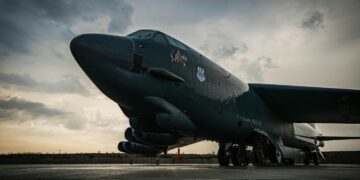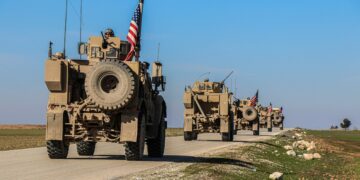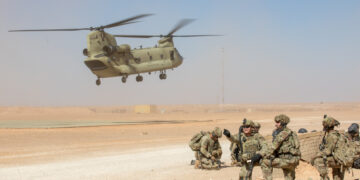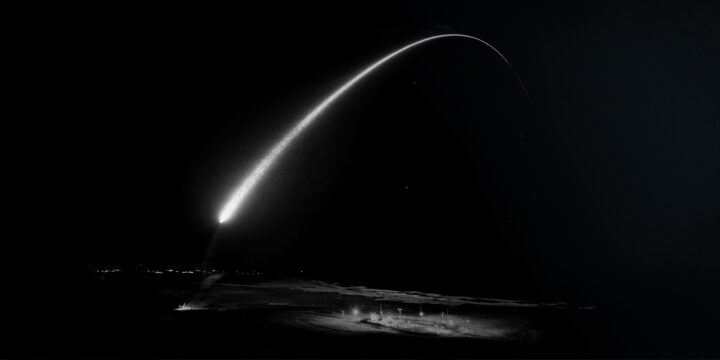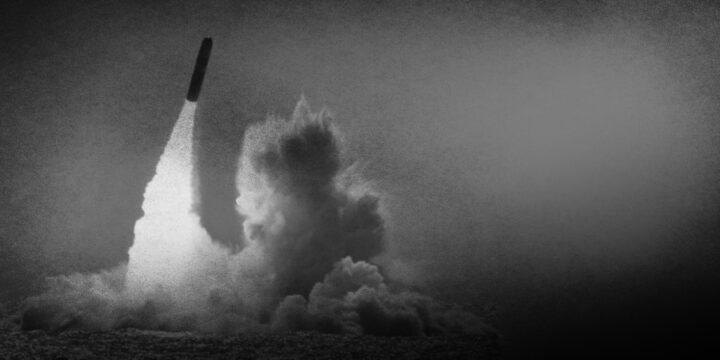September 16, 2021
Considering the utility of an Iranian nuclear bomb
By Mike Sweeney
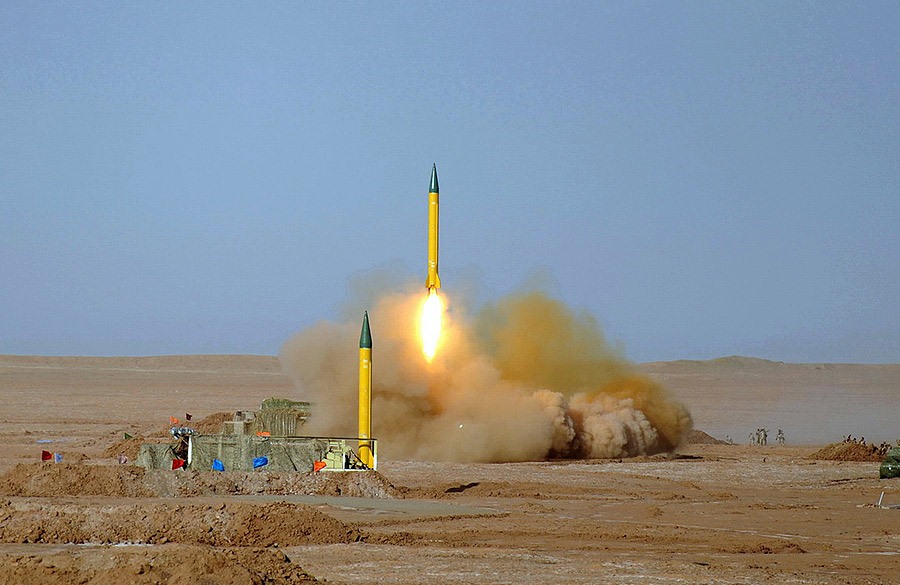
Key points
- Iran is traditionally perceived as willing to negotiate over its nuclear program due to economic concerns. But it is also possible—though not certain—Tehran recognizes there might be practical constraints on the military and strategic value of a potential nuclear arsenal.
- At least initially, Iran’s nuclear capability would be significantly limited—in number of warheads and weapon yield—compared to other established nuclear powers. These deficiencies could confine an Iranian bomb to a tool of last resort, rather than an instrument of active coercion.
- It will be difficult for Iran to expand the quality and yield of its warheads without taking overtly provocative steps like restarting its heavy water reactor at Arak or conducting nuclear testing.
- Iranian dependence on liquid-fueled missiles, like the Shahab-3, could affect its ability to reliably deliver a nuclear warhead. In the specific case of Israel, its robust missile defenses could make it even more difficult for Iran to strike with assurance.
- Iran crossing the nuclear threshold could negatively impact its security environment long term if it sparks additional countries in the Middle East to develop their own nuclear weapons.
Why does Iran keep negotiating?
Over the past fifteen years, Iran has repeatedly engaged in negotiations to limit its ability to acquire nuclear weapons.1The first proposal proffered by the P5+1 (i.e., China, France, Germany, Russia, the United Kingdom, and the United States) offering incentives for Iran to cease enrichment of highly enriched uranium was in June 2006. See “Timeline of Nuclear Diplomacy with Iran,” Arms Control Association, Reviewed July 2021, https://www.armscontrol.org/factsheets/Timeline-of-Nuclear-Diplomacy-With-Iran. If all else was equal, why not pursue a nuclear weapon single-mindedly, without reservation? Iran is an advanced technological state, with a large body of indigenous talent and resources to draw on in pursuit of a nuclear device. Moreover, it is a state with few reliable allies, isolated, in many ways, within its own region. Despite its limited global reach, it has a first-tier rivalry with the world’s preeminent power, the United States, which maintains its own large nuclear arsenal and also has never hidden its animosity for the regime that has reigned in Tehran since the 1979 Islamic Revolution.
Looked at dispassionately, Iran would seem an ideal candidate for nuclear weapons given its security needs and capacity for developing one. But its willingness to reenter negotiations on the Joint Comprehensive Plan of Action (JCPOA) with the Biden administration calls attention to the seeming ambiguity of Iranian intentions.
Part of the answer, of course, is international efforts, including the JCPOA, helped create barriers to Iran obtaining the necessary material and technology its nuclear program requires. Active interventions—ranging from the U.S. Stuxnet cyberattack revealed in 2010 to Israel’s assassination of the longtime head of the Iranian nuclear program in early 2021—also hurt Iran’s progress.2On Stuxnet, see Kim Fetter, Countdown to Zero Day, (New York: Broadway Books, 2014). On the assassination of Mohsen Fakhrizadeh, see Farnaz Fassihi, David E. Sanger, Eric Schmitt, and Ronen Bergman, “Iran’s Top Nuclear Scientist Killed in Ambush, State Media Say,” New York Times, Updated December 9, 2020, https://www.nytimes.com/2020/11/27/world/middleeast/iran-nuclear-scientist-assassinated-mohsen-fakhrizadeh.html. But while these factor into the delays in Iran developing a bomb, they do not explain why Tehran might be willing to forswear one entirely.
The main explanation usually proffered is Iran seeks the economic benefits of sanction relief. Others argue Iran is merely being disingenuous in diplomatic talks, seeking sanctions relief while planning to continue work on a bomb in secret. The former explanation is compelling given the dire state of Iran’s economy, while the latter argument can never be entirely disproved.
But it is also possible Iran recognizes there would be limited security benefits to deploying nuclear weapons. This becomes somewhat clearer when several factors are examined in detail including the nature of Iran’s potential arsenal, the capabilities of other regional states (notably Israel), and possible unwanted consequences—such as additional proliferation within the region.
As will be discussed below, the value of an Iranian bomb cannot be assessed in a vacuum; it is a variable that interacts with its surroundings in ways that offer benefits for Iran but also could entail significant costs. To be clear, the point of this analysis is not to argue that a nuclear Iran would be “no big deal.” Any expansion of the nuclear club is an extraordinarily serious matter, let alone in the case of an authoritarian theocracy. But it is to suggest there may be military and strategic reasons Iran has hesitated in its nuclear development, beyond the more widely assumed economic benefits it would receive from sanctions relief.
What would an Iranian nuclear capability look like?
The type and number of nuclear weapons Iran possesses will have important implications for how they can be used. In this case, function will follow form.
Iran has pursued nuclear weapons research in one form or the other, since at least the 1980s. But its path to a bomb has been fitful, with various stops and starts along the way.3“Timeline of Nuclear Diplomacy with Iran.” The predecessor to the current program, “Project Amad,” was halted unilaterally in late 2003.4Iran Nuclear Capabilities and Intentions, National Intelligence Estimate, November 2007, https://www.dni.gov/files/documents/Newsroom/Reports%20and%20Pubs/20071203_release.pdf. Documents from that project—some voluntarily turned over to the International Atomic Energy Agency (IAEA) and some captured by Israeli intelligence—provide insight into the size and capabilities of a potential Iranian nuclear arsenal.5For a useful, in-depth analysis of the materials stolen by Israeli intelligence, see David Albright with Sarah Burkhard and the Good ISIS Team, Iran’s Perilous Pursuit of Nuclear Weapons (Washington, DC: Institute for Science and International Security, 2021), https://isis-online.org/uploads/isis-reports/documents/Highlights_of_Irans_Perilous_Pursuit_of_Nuclear_Weapons_August_25%2C_2021.pdf. For debate over the extent to which the files constitute “new” information or merely information the IAEA already previously had access to, see Oliver Holmes and Julian Borger, “Nuclear Deal: Netanyahu Accuses Iran of Cheating on Agreement,” Guardian, April 30, 2018, https://www.theguardian.com/world/2018/apr/30/netanyahu-accuses-iran-cheating-nuclear-deal.
The objective of Amad appeared to be the fielding of five nuclear fission bombs, each with a yield of approximately 10 kilotons.6Albright et al., Iran’s Perilous Pursuit of Nuclear Weapons, 31–36, 271. By the standards of modern arsenals, five 10-kiloton bombs are relatively modest, although this is not to underestimate their significance. They would each be roughly equivalent to the “Little Boy” bomb dropped on Hiroshima, and it, obviously, was able to inflict extreme devastation when detonated over a densely populated city.7Little Boy’s yield was 12.5 kilotons and fatalities in Hiroshima were estimated at 140,000 through the end of 1945. Richard Rhodes, The Making of the Atomic Bomb: The 25th Anniversary Edition (New York: Simon & Shuster Paperbacks, 2012) Kindle edition, Location 14890 and 15370. But it is to put into context Iran’s potential arsenal compared to other countries, such as the United States, which features 1,800 operational weapons (with another 2,000 in reserve), some with yields in excess of 400 kilotons.8Hans M. Kristensen and Matt Korda, “United States Nuclear Forces, 2021,” Bulletin of the Atomic Scientists, vol. 77, no. 1 (January 26, 2021): 44. https://doi.org/10.1080/00963402.2020.1859865.
An important characteristic of the Iranian program is that it is based on highly enriched uranium (HEU), one of two substances capable of fueling a nuclear weapon. The other is plutonium, which Iran does not yet produce in weapons grade. The significance of this is two-fold.
First, less plutonium is needed to make a nuclear weapon than the equivalent amount of HEU, roughly 4 kg compared to 12 kg, respectively, for a basic bomb—although larger amounts could be required depending on the efficiency of the design.9These estimates are based on declassified U.S. government figures cited in Global Fissile Material Report 2013 (Princeton: International Panel on Fissile Materials, 2013): 92. Among other advantages, this allows for smaller warheads, more easily delivered by missile and at greater range.
Second, although it is not necessarily required, plutonium is often used in the design of fusion warheads, also known as thermonuclear weapons. These are bombs that employ nuclear fission to trigger a second reaction in which atoms are forced together (as opposed to being split), creating exponentially more destructive energy than with fission alone.10Martin E. Hellman, “The Physics of Nuclear Weapons,” Undated, Accessed July 14, 2021, https://ee.stanford.edu/~hellman/sts152_03/handout02.pdf.
The importance of Arak
Iran does have the potential to produce plutonium at its heavy water reactor at Arak and at its light water reactor at Bushehr. Of the two, Arak is the much greater concern. Heavy water reactors are far more efficient at producing weapons-grade plutonium and do so to higher purity levels.11Tehran operates Bushehr under an agreement with Moscow whereby Iran returns spent fuel rods from the reactor to Russia. If Iran violated this agreement, it could attempt to extract plutonium from the spent rods. But one problem with this method is that the purity of plutonium produced in light water reactors (like Bushehr) is less than optimal for weapon use, running high in the isotope Pu-240 and lower in the more desirable Pu-239. While this type of plutonium can technically fuel a bomb, its use might compromise both the reliability and yield of the weapon. In contrast, heavy-water reactors like Arak have been a reliable source of weapons-grade plutonium for multiple established nuclear weapons programs. On the shortcomings of Bushehr as a source of weapons-grade plutonium, see Jack Boureston and Charles D. Ferguson, “Assessing Iran’s Plutonium Reprocessing Capabilities: A Way to Obtaining Nuclear Weapons Material,” Iran Watch, March 1, 2004. https://www.iranwatch.org/library/private-viewpoints/assessing-irans-plutonium-reprocessing-capabilities-way-obtaining-nuclear-weapons-material. One of the main contributions of the JCPOA was soliciting Iranian agreement to shut down Arak and restructure the facility in such a way as to preclude the generation of weapons-grade plutonium.12William J. Broad, “Plutonium Is Unsung Concession in Iran Nuclear Deal,” New York Times, September 7, 2015, https://www.nytimes.com/2015/09/08/science/irans-unsung-plutonium-concession-in-nuclear-deal.html.
In March of this year, Tehran announced it had undertaken preparations to restart the reactor later in 2021.13“Iran Says to Cold Test Redesigned Arak Nuclear Reactor,” Reuters, March 19, 2021, https://www.reuters.com/article/us-iran-nuclear/iran-says-to-cold-test-redesigned-arak-nuclear-reactor-idUSKBN2BB0K0. It is unclear whether the redesign of the site remains in effect, but a law passed in December 2020 by the Iranian parliament mandated reverting Arak to its original status.14Julia Masterson, “Iran Ratchets Up Nuclear Program,” Arms Control Association, March 2021, https://www.armscontrol.org/act/2021-03/news/iran-ratchets-up-nuclear-program. In its original configuration, Arak was estimated to generate enough weapons-grade plutonium for two bombs a year.15Masterson, “Iran Ratchets Up Nuclear Program.” A basic plutonium design—like the “Fat Man” device dropped on Nagasaki—would provide Iran a weapon with roughly twice the yield of an HEU bomb, or 20 kilotons.16Fat Man’s yield was estimated at 22 kilotons. Rhodes, The Making of the Atomic Bomb, Kindle location 15520.
A restart of Arak would also be important to weapons design for a second major reason: it could allow Iran to produce tritium. If Iran wants to significantly increase the yield of its weapons and also miniaturize them to facilitate missile delivery, it needs to do one of two things: either employ a boosting agent for basic fission weapons or develop a thermonuclear weapon. The latter option is technologically a tall order. India, for example, does not appear to have mastered this technology despite having had nuclear weapons since 1974, although North Korea might have done so.17On India and North Korea’s respective efforts to test a thermonuclear device, see Jeffrey Lewis, “India’s H Bomb Revisited,” Arms Control Wonk, April 27, 2009, https://www.armscontrolwonk.com/archive/202445/indias-h-bomb-revisited/; Jeffrey Lewis, “Welcome to the Thermonuclear Club, North Korea!” Foreign Policy, September 4, 2017, https://foreignpolicy.com/2017/09/04/welcome-to-the-thermonuclear-club-north-korea/.
But even if a viable fusion design was in hand, Iran would still need the radioactive isotopes, tritium and deuterium, to construct a functioning device.18Hellman, “The Physics of Nuclear Weapons,” 6–9. While deuterium is readily available as a derivative of seawater, tritium can only be produced in certain types of nuclear reactors, including heavy water facilities, like Arak in its original configuration.
Key Iranian nuclear facilities
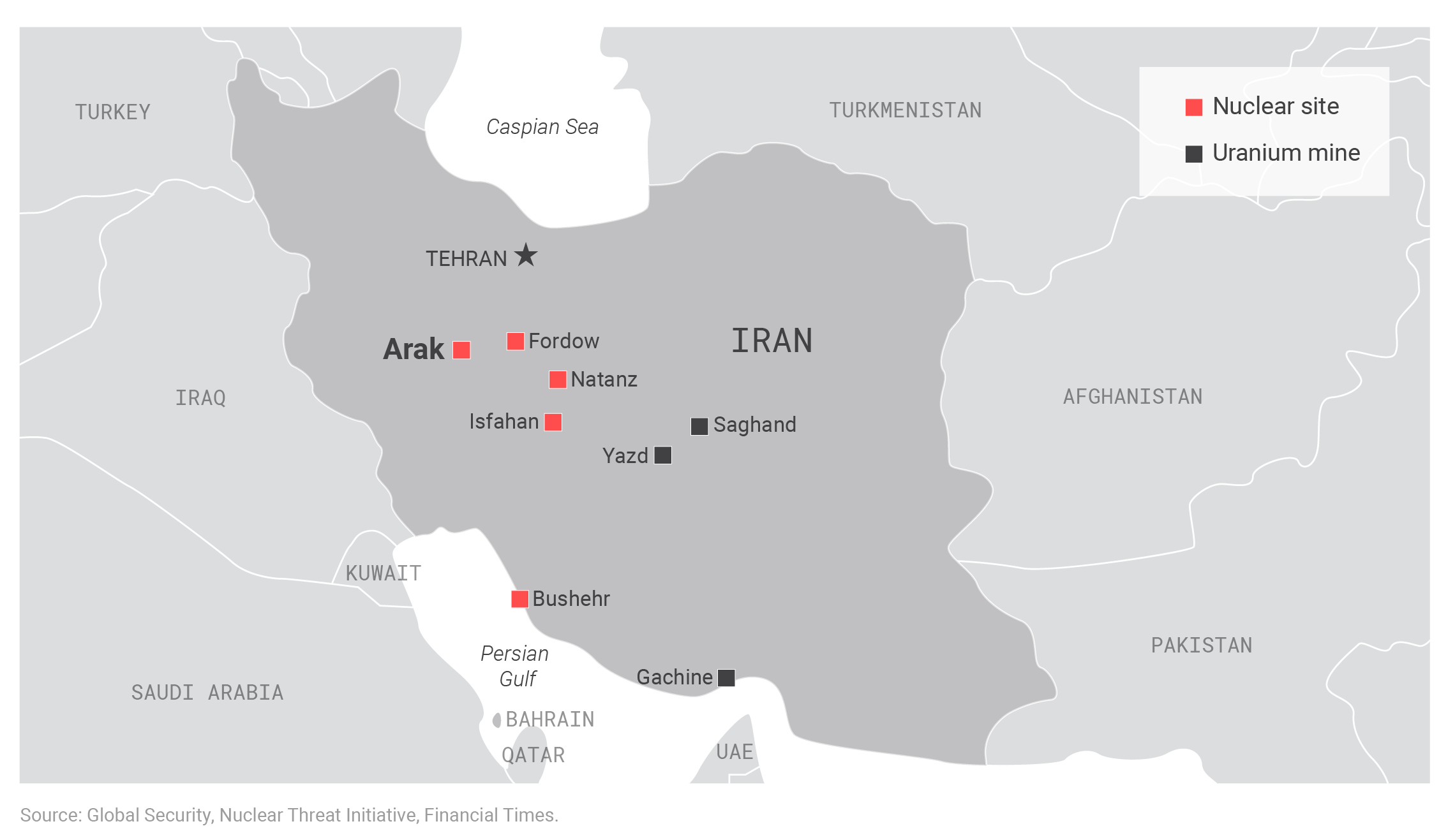
Iran’s most important nuclear site is arguably Arak. If restarted in its original heavy-water configuration, it would be capable of producing both weapons-grade plutonium and the boosting isotope tritium. Other important facilities include Natanz and Fordow, where Iran enriches uranium, and Isfahan, a research center and conversion site for uranium hexafluoride, a precursor to HEU.
These same isotopes are also used as boosting agents for fission bombs, allowing for substantial increases in yield without the complexity of a thermonuclear design. The largest fission detonation ever—an estimated 400 kilotons—was achieved by the Soviet Union using tritium and deuterium in its so-called “layer cake” design in 1953.19Houston T. Hawkins, “History of the Russian Nuclear Weapon Program,” Los Alamos National Laboratory, November 19, 2013, Slide 37, https://fas.org/nuke/guide/russia/lanl-history.pdf. Iran is unlikely to build a device of this size, but it could use tritium to reduce the amount of fissile material needed in its weapons, creating smaller warheads while enhancing yields.
Without tritium (and possibly plutonium), Iran would be confined to relatively rudimentary fission designs and limited yields. Iran could purchase tritium, but the isotope has a relatively short half-life, losing its potency after roughly 12 years and requiring replacement.20“Tritium,” U.S. Department of Energy, Accessed July 30, 2021, https://www.energy.gov/sites/prod/files/migrated/nnsa/2017/11/f42/Tritium%20Fact%20Sheet%20Oct%2017%202011.pdf. Thus, without an indigenous source of tritium production, advanced boosting designs could not be guaranteed to remain viable over time.
Reliability, survivability, and deliverability
Simply assembling a bomb would not constitute an operational deterrent for Iran. Nuclear weapons must be at least three things to constitute an effective threat: reliable, survivable, and deliverable. Given the options for concealment presented by Iran’s terrain and physical size, it is plausible to posit that an Iranian nuclear weapon could be highly survivable against preemptive attack, particularly if there were more than one. However, more serious questions could be asked about an Iranian bomb’s reliability and the means to deliver it with assurance.
Eight of the nine current nuclear states developed their programs through the use of testing. The Soviet Union and United States in particular were prolific in the number of nuclear tests they performed during the early decades of their programs.21“The Nuclear Testing Tally,” Arms Control Association, July 2020, https://www.armscontrol.org/factsheets/nucleartesttally. Recent entrants into the nuclear club, like Pakistan and North Korea, have been more selective in their tests, yet conducted them nonetheless.
The outlier is Israel. However, in the early years of its nuclear program, Israel was able to draw on access to French nuclear testing data in designing its weapons, before the falling out in relations between the two countries 1967.22Hans M. Kristensen and Robert S. Norris, “Israeli Nuclear Weapons, 2014,” Bulletin of the Atomic Scientists, vol. 70, no. 6 (November 27, 2015): 104, https://doi.org/10.1177/0096340214555409. Israel may also have, in fact, conducted one nuclear test, possibly in collaboration with South Africa in 1979, an episode sometimes known as the Vela Incident, after the U.S. spy satellite that detected it.23See Avner Cohen and William Burr, “Revisiting the 1979 VELA Mystery: A Report on a Critical Oral History Conference,” The Wilson Center, August 31, 2020, https://www.wilsoncenter.org/blog-post/revisiting-1979-vela-mystery-report-critical-oral-history-conference.
At some point, Iran is likely going to have to test as well. This particularly would be the case if it opts to move beyond basic fission designs to either boosted weapons or a thermonuclear weapon. This will present a dilemma for Tehran. Even an underground test cannot be concealed from U.S. and international seismic monitoring. Once Iran crosses that threshold, it will be clearly known. Among other results, it could make it far easier for the United States to organize renewed sanctions and other punitive measures within the international community in response.
But more important, an Iranian test would open the door to possible military strikes on its nuclear infrastructure. At a minimum, attacks could be conducted—either by the United States or Israel—to destroy the Arak reactor, the source of Iran’s tritium and plutonium, and also possibly the Natanz and Fordow facilities, where Iran enriches uranium into HEU.
This is not to argue that any of these sites would be easy targets. Natanz in particular is deep within Iranian territory and is a hardened, underground facility. There also would be difficult questions about the consequences of striking active nuclear reactors—in the case of Arak and Natanz—considering the potential for radioactive contamination of surrounding areas.
But an action as provocative as a nuclear test could tip the balance against these concerns. In short, the consequences of a nuclear test easily could deprive Iran of the means to produce fissile material, confining it to whatever stocks it had on hand at the time of the test.
Or Iran could decide not to test. For more advanced designs, this would be extremely risky. While computer modeling offers important tools to weapons designers, the complexities of nuclear devices still necessitate practical experimentation to validate a weapon will work as intended. Otherwise, Iranian leaders could be faced with a situation where they order nuclear use—with all the attendant negative consequences that could incur—without true certainty the weapon will detonate properly. They essentially would be gambling their country on a theory.
The one possible exception to this could be if Iran opted for a certain type of fission bomb. HEU “gun injection” designs are 75-year-old technology and highly reliable.24Hellman, “The Physics of Nuclear Weapons,” 2–4. That said, the captured Project Amad documents showed Tehran was pursuing a more complex implosion HEU design prior to 2003, rather than gun injection.25An implosion design relies on precisely timed, simultaneous detonation of conventional explosives to compress a fissile core, thereby creating the nuclear reaction. On the Iranians foregoing the gun design in favor of implosion, see Albright et al., Iran’s Perilous Pursuit of Nuclear Weapons, 51. Part of the reason might be that implosion warheads can be much smaller than gun injection models, presenting a lighter load for potential delivery systems.26“Types of Nuclear Weapons,” Comprehensive Nuclear-Test-Ban Treaty Organization, Accessed July 30, 2020. https://www.ctbto.org/nuclear-testing/types-of-nuclear-weapons/. As with a plutonium device, the optimal approach would be to validate an HEU implosion design through an actual test.
The limitations of the Iranian air force
Another hallmark of traditional nuclear programs is to initially pursue an air-dropped weapon as the initial means of delivery. Iran is unlikely to follow this path. On paper, Iran would seem to have an impressive air force, with some 300 planes of various types, including several U.S. designs, which constitute almost two-thirds of its force structure.27International Institute for Strategic Studies, “Chapter Six: Middle East and North Africa,” The Military Balance, published online February 24, 2021, 340, https://doi.org/10.1080/04597222.2021.1868796. But these aircraft—including F-14 Tomcats and F-4 Phantoms—are in their fifth decade of service, having been procured by the Shah’s regime prior to the 1979 revolution.28For more detailed discussion of the tactics Iran has employed to keep its U.S.-made aircraft operational, see Daniel Salisbury, “Tomcat and Mouse: Iranian Illicit Procurement of U.S. Legacy Military Technologies, 1979–2016,” Strategic Trade Review, vol. 3, no. 5 (Autumn 2017): 25–46, https://www.belfercenter.org/sites/default/files/files/publication/Salisbury%20-%20Tomcat%20and%20Mouse.pdf. Open-source estimates, like The Military Balance, suggest that perhaps 60 percent of Iran’s U.S.-made planes are still operational, but even that figure might be optimistic.29“Chapter Six: Middle East and North Africa,” The Military Balance, 340. More important, most of these aircraft were not designed to deliver nuclear weapons, including the Tomcat, which was never used in a nuclear role by the United States.
The same can be said of Iran’s small force of MiG-29 fighters, which it purchased from Russia in the 1990s. Arguably Iran’s most advanced aircraft, the MiG-29s are optimized for air-to-air interdiction against other planes, not for dropping ordnance.
Iran does operate Su-24 tactical bombers—including multiple planes confiscated from Iraq during the 1991 Gulf War—and they would be one possible mode of air delivery along with the Phantom, which was once assigned the U.S. nuclear mission. But it seems unlikely Iran would be willing to trust one of a small supply of nuclear weapons to these airframes. They have no stealth characteristics and would face advanced fighter aircraft and air defenses if they attempted to deploy a bomb against one of the states of the Gulf Cooperation Council (GCC), where the United States bases the bulk of its forces in the Middle East.30For a detailed accounting of GCC fighter aircraft and air defenses, see “Chapter Six: Middle East and North Africa,” The Military Balance, 332, 349, 362, 364–365, 372. For more on U.S. deployments in the GCC, see Mike Sweeney, A Plan for U.S. Withdrawal from the Middle East, Defense Priorities, December 2020, 3–5, https://www.defensepriorities.org/explainers/a-plan-for-us-withdrawal-from-the-middle-east. An Iranian F-4 or Su-24’s ability to successfully penetrate Israeli defenses is even more suspect.
Iran’s main challenge: Reliable missile delivery
Almost certainly, Iran would instead follow North Korea’s example and move straight to missile delivery as the primary means of nuclear employment. For all intents and purposes, missiles already are Iran’s air force, at least in terms of projecting force outside its own airspace. Moreover, as the retaliatory strikes launched in response to the killing of Qassem Soleimani illustrate, Iran has made impressive strides in the quality of its weapons. But these attacks also highlight an important challenge Iran will face in attempting to employ a nuclear-capable missile.
Although there remains some debate on the matter, the strikes against the Ain al-Asad and Erbil bases in Iraq appeared to employ variants of both the Fateh solid-fueled missile and the Qiam liquid-fueled missile.31The situation has been confused by Iran’s initial assertion that it only used Fateh variants, followed by later U.S. assertions that suggested the attack was carried out exclusively with Qiam variants. Outside analysis tends to support the notion of a hybrid attack. See, for example, the technical assessment carried out by Fondation pour la Recherche Stratégique featuring satellite imagery of the attack site: Agnès Levallois, Vincent Tourret, and Stéphane Delory, “Iranian Operations Against el-Asad and Erbil Bases: What Can Be Learned from the Imagery?—Part One,” Fondation pour la Recherche Stratégique and Geospatial for Intelligence, February 12, 2020, https://www.frstrategie.org/sites/default/files/documents/publications/images-strategiques/2020/strategic-imagery-iranian-operations-against%20el-asad-and-erbil-bases-part-1.pdf; Agnès Levallois, Vincent Tourret, and Stéphane Delory, “Iranian Operations Against el-Asad and Erbil Bases: What Can Be Learned from the Imagery?—Part Two,” Fondation pour la Recherche Stratégique and Geospatial for Intelligence, February 12, 2020, https://www.frstrategie.org/sites/default/files/documents/publications/images-strategiques/2020/strategic-imagery-iranian-operations-against%20el-asad-and-erbil-bases-part-2.pdf. The Fateh variant, perhaps the Zolfaghar, performed better than expected, demonstrating a new level of accuracy.32Michael Elleman, “Iran’s Missiles: Evolution and Arsenal,” The Iran Primer, United States Institute of Peace, January 15, 2021, https://iranprimer.usip.org/blog/2021/jan/15/biden-iran-missile-program. The Qiam variants that reached their target also appeared more accurate than anticipated.33Levallois, Tourret, and Delory, “What Can Be Learned from the Imagery?—Part Two,” 7. But several Iranian missiles—four out of sixteen according to the Department of Defense—failed in flight.34Dan Lamothe, “These U.S. Troops Survived One of the Greatest Crises of the Trump Era. A Year Later, They’re Still Coping,” Washington Post, January 10, 2021, https://www.washingtonpost.com/national-security/us-military-iran-missile-attack/2021/01/10/651c3930-4fb0-11eb-b2e8-3339e73d9da2_story.html. Early reports indicated these were liquid-fueled Qiam variants, with four of five aimed at Erbil crashing short of their targets.35Sebastien Roblin, “Meet the Qiam Missile Iran Used to Blast a U.S. Airbase,” National Interest, January 11, 2020, https://nationalinterest.org/blog/buzz/meet-qiam-missile-iran-used-blast-us-airbase-112911.
Estimated range of the Shahab-3 ballistic missile
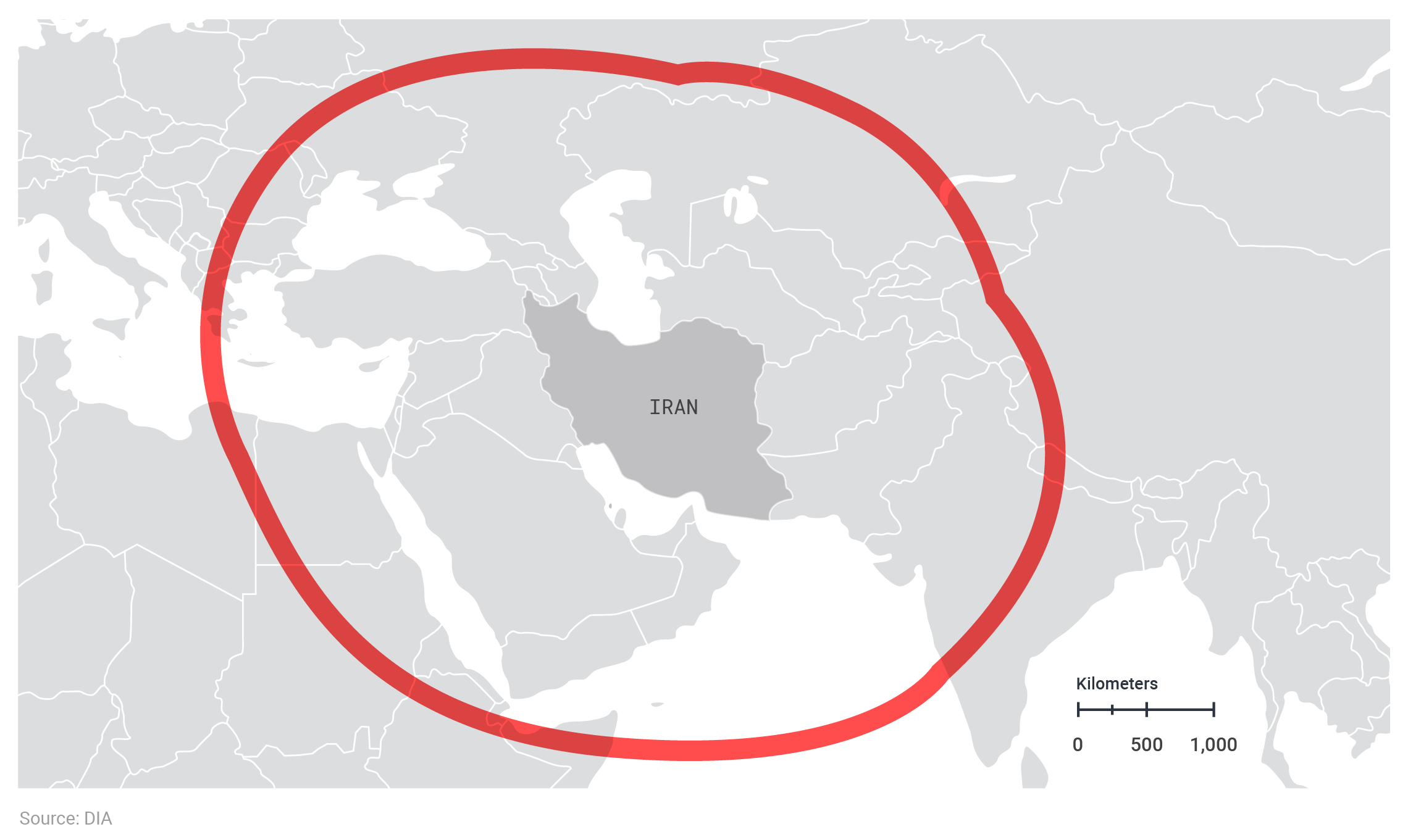
Iran’s principal means of nuclear delivery is likely to be the Shahab-3 liquid-fueled ballistic missile.
Regardless of the exact mix of systems used, it is important to recognize Iranian missiles overall had a 25 percent failure rate. And that figure might be considerably higher for just the liquid-fueled systems, if, in fact, it was the Qiam variants that malfunctioned.
This assessment is important to a potential Iranian nuclear capability because the missile Iran would most likely use to deliver a nuclear warhead—especially against Israel—would be the Shahab-3, a liquid-fueled medium-range ballistic missile (MRBM) that is a copy of the North Korean Nodong.36“Shahab-3,” Missile Threats, Center for Strategic and International Studies, Updated July 31, 2021, https://missilethreat.csis.org/missile/shahab-3/. Having its primary delivery vehicle be liquid-fueled adds another layer of risk to successful nuclear employment.
Obviously, there is no guarantee the Shahab-3 would not perform as expected, but as the attacks on Ain al-Asad and Erbil illustrate, there is also reason to question if its reliability would be 100 percent, particularly at the outer limits of its range. Would even a 5 or 10 percent failure rate be acceptable for a country with a very limited number of warheads?
Developing a solid-fueled missile capable of delivering a warhead throughout the Middle East would increase the reliability (and response time) of Iran’s nuclear forces.37Liquid-fueled systems generally have longer range and greater payload capacity compared to solid-fueled systems of the same class. Solid-fueled missiles, on the other hand, offer the advantage of being stored ready-to-fire, skipping the lengthy fueling process liquid systems must undergo. They are a more difficult technology to develop, but their solid-state tends to make them more reliable and stable. For a more detailed discussion of the characteristics of ballistic missiles, see John Pike with Steven Aftergood, “Ballistic Missile Basics,” Federation of American Scientists, Updated June 4, 2000, https://fas.org/nuke/intro/missile/basics.htm. Iran appeared to be making progress in this area during the 2000s, with the development of the Sejjil solid-fueled MRBM, but work on the system apparently faltered around 2011. The Sejjil was presumed abandoned until it reappeared in January 2021 and was reportedly launched during military exercises. Its status beyond that test is unclear.38See Open-Source Analysis of Iran’s Missile and UAV Capabilities and Proliferation, International Institute for Strategic Studies, April 2021, 17, https://www.iiss.org/blogs/research-paper/2021/04/iran-missiles-uavs-proliferation. Michael Elleman has suggested it would take a year or two of additional testing for Sejjil to be considered operational. See Elleman, “Iran’s Missiles: Evolution and Arsenal.”
There are additional considerations with respect to reliable delivery. Although the Project Amad documents show Iran had begun working on the problem of mating a nuclear warhead to a missile, there remain important technological challenges to master.39The effort under Amad to mate a nuclear warhead to the Shahab-3 missile was known as Project 111. See Albright et al., Iran’s Perilous Pursuit of Nuclear Weapons, 200–217. First, the warhead design must be capable of withstanding the intense temperature changes and stresses of ballistic missile flight.40Early in its nuclear weapons program, Chinese weaponeers had sufficient concerns about their warhead’s ability to withstand the extreme temperature changes and intense vibrations associated with ballistic missile flight that they actually test-fired a live weapon atop a ballistic missile to validate the design. See Jeffrey Lewis, Paper Tigers: China’s Nuclear Posture (London: International Institute for Strategic Studies, 2014): 49–50. Second, the bomb also must detonate at an optimum height to maximize the effects of a blast. A weapon that detonates too high can dissipate much of its destructive energy, while a blast at ground level also decreases its destructive power (or could even damage the warhead on impact, rendering it a radioactive dud.) This process of correctly “fuzing” a warhead is another step that will delay the transition from Iran assembling a viable nuclear bomb to it having an actual operational capability.
The characteristics of an Iranian deterrent
What then does the foregoing say about the nature of a possible Iranian nuclear capability? First, it is likely limited to basic fission bombs and yields in the neighborhood 10 kilotons, unless Iran is willing to take the provocative step of restarting Arak and the even more inflammatory act of testing advanced nuclear designs. Second, it would be reliant, at least initially, on liquid-fueled missiles for delivery—which entail some risk of inflight failure—until such time as a solid-fueled system is in the field, with adequate range and throw-weight. Third, numbers would be in the low single digits, likely with warheads dispersed throughout the country for survivability, rather than on immediate standby at a fixed location.
Iran’s would be a force largely optimized for defensive purposes, to either deter or punish an attempt at invasion. To be clear, “defensive” should not be conflated with “benign.” Defensive use could include retaliatory threats against large civilian populations—most prominently, Israel’s.
How would Iranian nuclear forces compare to the Israeli deterrent?
Israel is arguably the main object of Iranian nuclear planning for two reasons. The first is its close political and security relationship with the United States, which makes it an ideal surrogate absent Iran’s ability to threaten the United States directly. Beyond this, Israel is, in its own right, one of Iran’s two main regional rivals, along with Saudi Arabia.
Iran’s ability to credibly threaten Israel with nuclear weapons is thus a prime measure of how valuable Tehran’s arsenal would be to it. But such an assessment does not take place in a vacuum. Israel’s ability to counter Iranian threats and inflict retaliation, if necessary, also must be weighed. Israeli strategic capabilities—to include non-nuclear assets like missile defenses—therefore must figure into calculations on the utility of an Iranian bomb.
Israeli nuclear weapons
Israel has been a nuclear power since the late 1960s, although it has never officially declared itself to be so.41For background on Israel’s nuclear program, see Avner Cohen, Israel and the Bomb (New York: Columbia University Press, 1998). This reticence has led to a fair amount of speculation—and even mystique—around the Israeli nuclear program. This confounds efforts to accurately assess it and, in some cases, perhaps has led to its exaggeration. Still, a clear-eyed reading of Israeli nuclear capabilities and (just as important) the means for delivering them illustrates Israel has vastly superior nuclear forces than what Iran would field.
Responsible estimates peg Israel’s nuclear inventory at about 90 weapons, though it might have the fissile reserves to produce twice that amount if it chose to do so.42Estimate of Israeli warheads taken from Hans M. Kristensen and Matt Korda, “VIII. Israeli Nuclear Forces,” in “10. World Nuclear Forces,” SIPRI Yearbook 2021: Armaments, Disarmaments, and International Security, (Stockholm: Stockholm International Peace Research Institute, 2021): 391, https://www.sipri.org/sites/default/files/2021-06/yb21_10_wnf_210613.pdf. For more on the debate over Israel’s potential stockpile of fissile material and its implications for the potential size of its arsenal, see Kristensen and Norris, “Israeli Nuclear Weapons, 2014,” 102–103. Israel is known to have access to tritium—and may be constructing a new production facility for the isotope at Dimona—which implies it has at least boosted fission bombs.43Sang Min-Kim, “New Work Underway at Israeli Nuclear Site,” Arms Control Association, April 2021, https://www.armscontrol.org/act/2021-04/news/new-work-underway-israeli-nuclear-site. There has been conjecture Israel also has thermonuclear weapons or possibly enhanced radiation weapons (ERW), better known as the neutron bomb. But claims regarding thermonuclear devices and ERW have never been substantiated.44Kristensen and Norris, “Israeli Nuclear Weapons, 2014,” 104–105.
Comparison of strategic capabilities
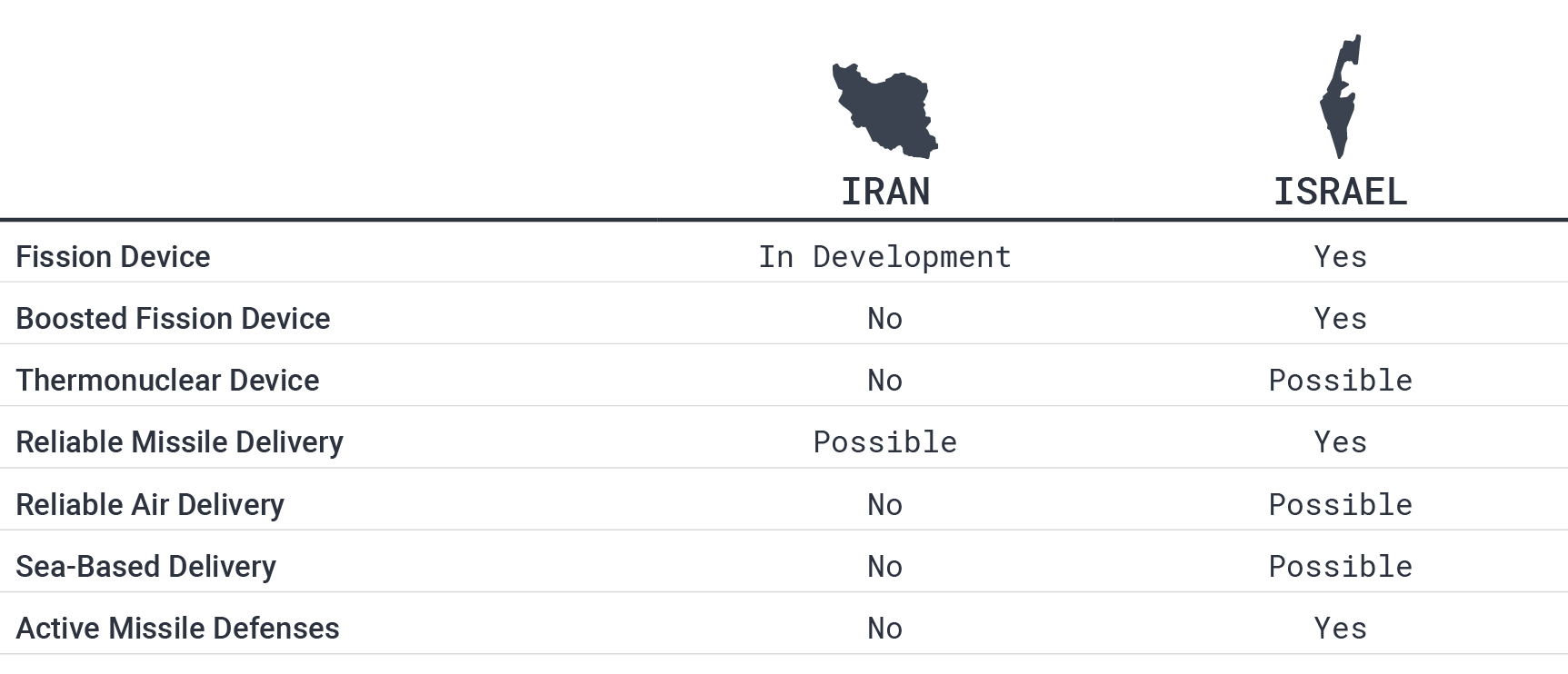
There is a remarkable dearth of information in the public sphere on potential yields of Israeli nuclear weapons. However, some figures can be derived from conjecture concerning other “second tier” nuclear powers. For example, India’s arsenal is estimated to include fission bombs with yields of 40 kilotons and that is a reasonable lower baseline for Israeli capabilities.45Indian yield taken from Hans M. Kristensen and Matt Korda, “Indian Nuclear Forces, 2020,” Bulletin of the Atomic Scientists, vol. 76, no. 4 (July 20, 2020): 218, https://doi.org/10.1080/00963402.2020.1778378. But it is possible Israel could have more sophisticated designs and 100 kilotons seems plausible as a notional upper baseline for bounding the yield of Israel’s boosted fission weapons. If, in fact, Israel has a thermonuclear weapon, yields could be significantly higher. For example, in 2017, North Korea is believed to have tested a fusion device with an output between 140 and 280 kilotons.46Ankit Panda, “U.S. Intelligence: North Korea’s Sixth Test Was a 140 Kiloton ‘Advanced Nuclear’ Device,” Diplomat, September 6, 2017, https://thediplomat.com/2017/09/us-intelligence-north-koreas-sixth-test-was-a-140-kiloton-advanced-nuclear-device/; Frank V. Pabian, Joseph S. Bermudez Jr., and Jack Liu, “North Korea’s Punggye-ri Nuclear Test Site: Satellite Imagery Shows Post-Test Effects and New Activity in Alternate Tunnel Portal Areas,” 38 North, The Stimson Center, September 12, 2017, https://www.38north.org/2017/09/punggye091217/.
The foregoing are simply educated guesses about Israeli yields and, in particular, there is no hard evidence of a thermonuclear capability. Whatever their exact potency, Israeli nuclear warheads are substantially more powerful than what Iran will have in its inventory and far more numerous.
Israeli delivery systems
Israel also trumps Iran in a second essential area: deliverability. Israel is thought to have an air-delivery capability based on either its F-15s, which has previously been assigned the nuclear mission by the United States, or its F-16s, which is assigned a nuclear role by some NATO countries.47Kristensen and Norris, “Israeli Nuclear Weapons, 2014,” 105–106. Israel also operates the stealthy F-35, which is currently undergoing certification for the nuclear role in the United States.48Nuclear certification for the F-35 is expected by January 2023. U.S. Library of Congress, Congressional Research Service, F-35 Joint Strike Fighter (JSF), RL30563 (2020), 22, https://fas.org/sgp/crs/weapons/RL30563.pdf.
But if it came to nuclear employment against Iran, Israel is likely to rely on its missile capabilities. Since the mid-1980s, it has operated the solid-fueled Jericho 2 missile, which is able to range most of western Iran, although not Tehran itself.49Kristensen and Norris, “Israeli Nuclear Weapons, 2014,” 107. In 2011, this capability was substantially augmented with the introduction of the Jericho 3—which has the ability to cover all of Iran and can reach as far east as Pakistan and as far north as Moscow.50Kristensen and Korda, “VIII. Israeli Nuclear Forces,” 393–394. The Jericho 3 affords Israel the type of reliable, quick-launch capability Iran simply does not have. Israel bases its Jericho missiles at Sdot Micha, with estimates on numbers ranging from 25 to 50 missiles.51The issue of the precise number of launchers is confused by Israel’s general opacity on nuclear matters and the specific question of whether the Jericho 3 has replaced or merely augmented the Jericho 2. See Kristensen and Norris, “Israeli Nuclear Weapons, 2014,” 107–108, and Kristensen and Korda, “VIII. Israeli Nuclear Forces,” 392–393.
Israel is also sometimes said to have a nuclear-armed submarine-launched cruise missile (SLCM) for its small fleet of Dolphin diesel-electric submarines. However, as with thermonuclear weapons, it is unclear if this capability exists. The premise for the rumor seems to be a request from the Israeli government in the 1990s to the Clinton administration, asking to buy the nuclear-capable version of the Tomahawk SLCM. The request was denied and there is no firm evidence of Israel developing its own SLCM indigenously.52Kristensen and Norris, “Israeli Nuclear Weapons, 2014,” 108–109.
Location of key Israeli strategic facilities
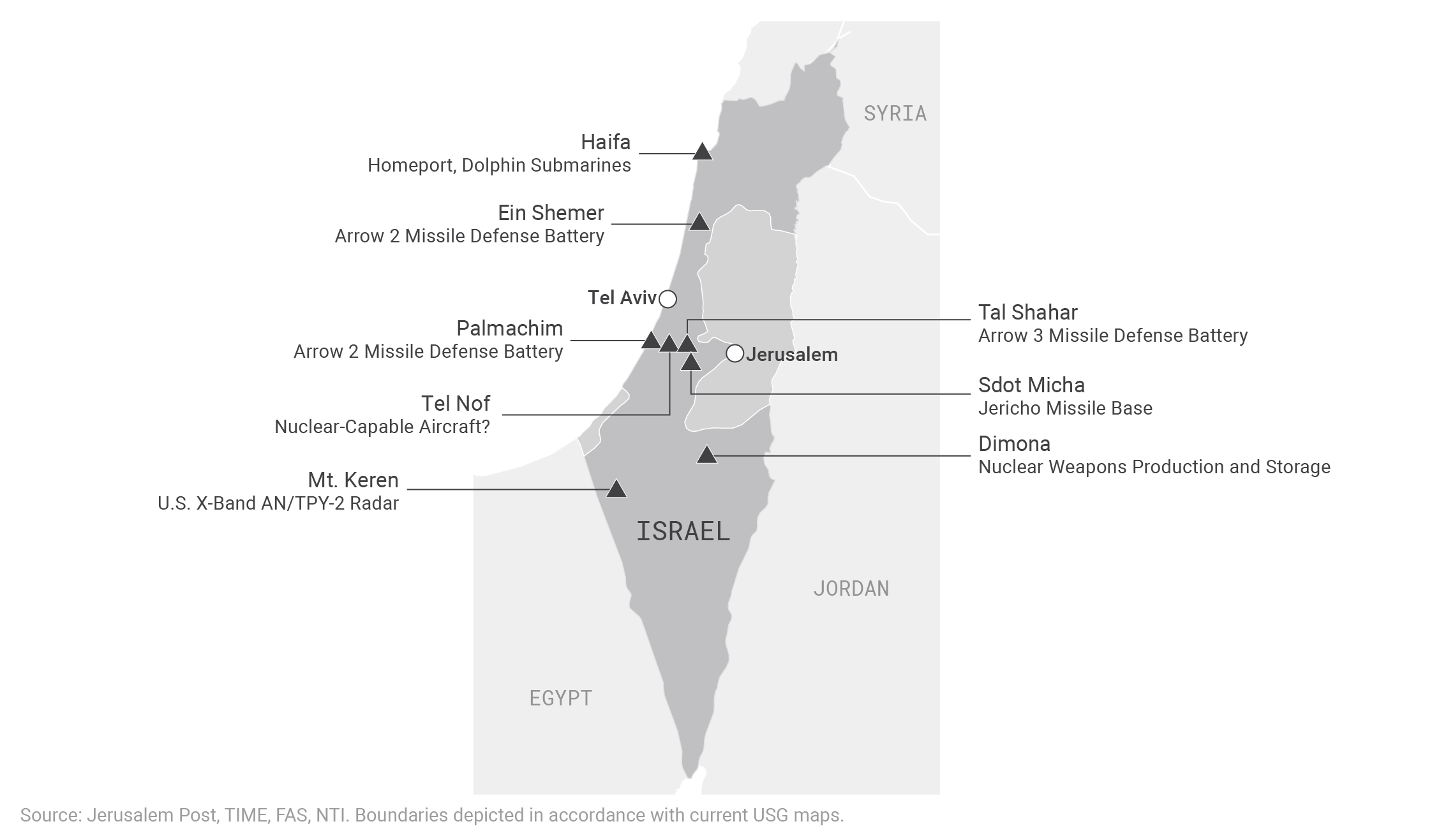
Israel’s nuclear arsenal is both larger and more potent than what Iran would initially field. It also features a reliable means of missile delivery in the solid-fueled Jericho 3. Israel has another critical advantage–robust active missile defenses like the Arrow 2 and 3 systems.
Israeli active defenses
Israel has a third essential advantage over Iran: active defenses which afford it the ability to shoot down incoming missiles. Israel is protected by a layered architecture of four systems, perhaps the most famous of which is the Iron Dome. But the Iron Dome, as well as another system known as David’s Sling, are designed for shorter range threats and would not have the capability to engage a medium-range missile like the Shahab-3. However, the other two layers do: Arrow 2 and Arrow 3.53For an overview of the Arrow systems’ characteristics, see “Arrow 2 (Israel),” Missile Threats, Center for Strategic and International Studies, Updated June 15, 2018, https://missilethreat.csis.org/defsys/arrow-2/; “Arrow 3 (Israel),” Missile Threats, Center for Strategic and International Studies, Updated June 15, 2018, https://missilethreat.csis.org/defsys/arrow-3/.
The former is a rough analog in capability to the U.S. Terminal High Altitude Air Defense (THAAD) system, while the latter is an even more advanced system with the range and ability to engage targets outside the earth’s atmosphere. Arrow 3 is actually capable of countering missiles with even greater range than the Shahab-3, although it would also have the ability to engage that system too. In fact, Arrow 3 appears to have been tested against a simulated Shahab-3 at a U.S. range in Alaska two years ago.54Joseph Trevithick, “Israel Tests Arrow 3 Interceptor’s Long Range Performance In First-Ever Alaskan Launches,” Drive, July 29, 2019, https://www.thedrive.com/the-war-zone/29194/israel-tests-arrow-3-interceptors-long-range-performance-in-first-ever-alaskan-launches.
Israel currently deploys two batteries of Arrow 2 at Palmachim and Ein Shemer and one battery of Arrow 3 at Tal Shahar.55Yaakov Katz, “IAF Mulls Further ‘Arrow’ Deployment,” Jerusalem Post, February 14, 2007, https://www.jpost.com/israel/iaf-mulls-further-arrow-deployment; Yaakov Lappin, “Israel Stepping Up Production of Arrow 3,” Jerusalem Post, June 5, 2013, https://www.jpost.com/defense/israel-stepping-up-production-of-arrow-3-315470. The Israeli Arrow systems are supported by a series of radars, known as Green Pine, but the United States also deploys one of its powerful X-band radars, the AN/TPY-2, on Mount Keren in the Negev Desert. While it is unclear if Israeli missile defenses receive data directly from the AN/TPY-2, it can still provide advanced notification of attack, perhaps affording Israel as much as six to seven additional minutes of warning of an incoming missile strike from Iran beyond Israel’s own detection capabilities.56Karl Vick and Aaron J. Klein, “How a U.S. Radar Station in the Negev Affects a Potential Israel-Iran Clash,” TIME, May 30, 2012, http://content.time.com/time/world/article/0,8599,2115955,00.html. The X-band radar also would facilitate the deployment of a THAAD battery to reinforce Arrow 2 and Arrow 3 during a crisis; the United States demonstrated its ability to do so by deploying THAAD to Israel in March 2019.57Judah Ari Gross, “IDF, U.S. Wrap Up Air Defense Exercise; THAAD Anti-Missile System to Leave Israel,” Times of Israel, April 1, 2019, https://www.timesofisrael.com/idf-us-wrap-up-air-defense-exercise-thaad-anti-missile-system-to-leave-israel/.
Of course, missile defenses should never be taken as foolproof. Too often, they are mistaken as conveying force-field like invulnerability. In truth, missile defenses are not built with perfection in mind. For example, traditionally, U.S. missile defense are believed to be engineered with intended reliability between 80 and 90 percent, and this seems a reasonable estimate for the intended effectiveness of THAAD and its Israeli counterparts.58Michael Elleman and Michael J. Zagurek, Jr., “THAAD: What It Can and Can’t Do,” 38 North, The Stimson Center, March 10, 2016, 5, https://www.38north.org/wp-content/uploads/pdf/2016-03-10_THAAD-What-It-Can-and-Cant-Do.pdf. The ability to fire multiple rounds can improve upon this number by boosting the probability a second or third shot will succeed where a first might fail. Having redundant layers of capabilities—as Israel would—also enhances the odds of success. But there are also questions about how these systems will perform under real world conditions.
Do the “factory settings” of 80 to 90 percent effectiveness hold up under wartime conditions? Unfortunately, that question probably can never be answered short of an actual conflict. But it would seem reasonable to postulate actual performance might not be as intended. What if effectiveness is closer to 50 or 60 percent? That could essentially turn the equation into a coin toss on successful nuclear delivery by Iran.
As sobering as that thought is, the advantage for Israel is the Iranian leadership also must contemplate these percentages—along with any lingering doubts as to the reliability of its own missile—and assess the chances of successfully completing a nuclear strike. There could be no worse outcome for Tehran than to launch a nuclear weapon and have it either fail or be interdicted. It would invite the worst possible consequences of nuclear attack, without actually inflicting any of the intended damage. Looked at from that perspective, Israeli active defenses have inherent deterrent value, even if their potential performance may not be as flawless as hoped.
No winners: Simulating an Iran-Israel nuclear exchange
Carefully parsing the Iran-Israel nuclear balance is important because it says much about how much coercive power Tehran would have with respect to Israel and, by extension, the United States if Iran crosses the nuclear threshold. The technical limits of Iran’s likely nuclear force carry implications for its practical utility.
The disparity in weapons yield, for example, is not merely an academic concern. It has implications for the destructiveness of weapons and that potency, in turn, has consequences for how a state’s nuclear arsenal is perceived, to include assessments of a government’s true willingness to use it.
NUKEMAP is an open-source tool for simulating the effects of nuclear blasts, developed by the nuclear historian Alex Wellerstein, based on open-source formulas developed to assess weapons impacts during the Cold War.59Alex Wellerstein, NUKEMAP 2.7, Restricted Data: The Nuclear Secrecy Blog. https://nuclearsecrecy.com/nukemap/. NUKEMAP essentially computerizes the circular slide rule that was developed during the Cold War to allow for manual calculations of the effects of nuclear weapons. See E. Royce Fletcher, Ray W. Albright, Robert F.D. Perret, Mary E. Franklin, I. Gerald Bowen, and Clayton S. White, Nuclear Bomb Effects Computer, (Including Slide-rule Design and Curve Fits for Weapons Effects), CEX-62.2 (Washington, DC: U.S. Atomic Energy Commission Civil Effects Test Operations, 1963). By using NUKEMAP to simulate strikes on Tel Aviv and Tehran, the importance of Israel’s superiority in weapon yield quickly becomes evident. (Tel Aviv is used here given the potential questions nuclear targeting of Jerusalem would raise for Iran, including the city’s significance to Islam and its large Muslim population.)
Notional attacks by Iran on Tel Aviv utilizing a 10-kiloton HEU bomb produce 77,480 Israeli deaths with 142,120 wounded.60NUKEMAP simulation of a strike on Tel Aviv run July 22, 2021. Assumes a 10-kiloton warhead with an airburst at 1,650 feet. https://nuclearsecrecy.com/nukemap/?&kt=10&lat=32.088545&lng=34.78254&hob_opt=2&hob_psi=5&hob_ft=1650&casualties=1&psi=20,5,1&zm=13. A simulated Iranian attack with a 20-kiloton plutonium device would kill 105,660 Israelis and wound 180,180.61NUKEMAP simulation of a strike on Tel Aviv run July 22, 2021. Assumes a 20-kiloton warhead with an airburst at 1,650 feet. https://nuclearsecrecy.com/nukemap/?&kt=20&lat=32.088545&lng=34.78254&hob_opt=2&hob_psi=5&hob_ft=1650&casualties=1&psi=20,5,1&zm=13. In contrast, an Israeli attack on Tehran with a 40-kiloton bomb would kill an estimated 358,950 and wound 866,230.62NUKEMAP simulation of a strike on Tehran run July 22, 2021. Assumes a 40-kiloton warhead with an airburst at 1,650 feet. https://nuclearsecrecy.com/nukemap/?&kt=40&lat=35.696&lng=51.401&hob_opt=2&hob_psi=5&hob_ft=1650&casualties=1&psi=20,5,1&zm=13. If Israel does have a more capable warhead, Iranian deaths go up even further. Using 100-kilotons as a notional yield, Israel would kill 565,520 Iranians in Tehran, with over 1.2 million wounded.63NUKEMAP simulation of a strike on Tehran run July 22, 2021. Assumes a 100-kiloton warhead with an airburst at 1,650 feet. Complete figure for estimated wounded is 1,224,090. https://nuclearsecrecy.com/nukemap/?&kt=100&lat=35.696&lng=51.401&hob_opt=2&hob_psi=5&hob_ft=1650&casualties=1&psi=20,5,1&zm=12.
For comparison purposes, a U.S. attack on Tehran with a single W88—the warhead carried by the submarine-launched Trident D-5 missile—could kill a staggering 1.2 million, while wounding an estimated 2.2 million Iranians.64NUKEMAP simulation of a strike on Tehran run July 22, 2021. Assumes a 455-kiloton warhead with an airburst at 1,650 feet. Complete estimated casualties are 1,243,130 dead and 2,197,900 wounded. https://nuclearsecrecy.com/nukemap/?&kt=455&lat=35.696&lng=51.401&hob_opt=2&hob_psi=5&hob_ft=1650&casualties=1&psi=20,5,1&zm=12. And Tridents carry up to five W88s per missile.65Technically, the Trident has the capacity to carry eight warheads, but due to limitations imposed by the New START Treaty, it likely deploys with five or fewer. See the explanation in Austin Long, “Discrimination Details Matter: Clarifying an Argument About Low-Yield Nuclear Warheads,” War on the Rocks, February 18, 2018, https://warontherocks.com/2018/02/discrimination-details-matter-clarifying-argument-low-yield-nuclear-warheads/.
To be absolutely clear, the point of this assessment is not to argue by some Strangelovian logic that Israel would somehow “win” such an exchange by “only” losing 77,000 citizens compared to much higher Iranian fatalities. There would be no winners—only wholesale death.
Rather it is to suggest Iran must also contemplate the exorbitant consequences of retaliation. Losing hundreds of thousands of its own people—perhaps in multiple cities, with total fatalities eventually reaching into the millions—is not some theoretical concern but a practical break on how reckless Tehran can be with nuclear weapons if it does develop them.
Estimated casualties for nuclear strikes on Tel Aviv and Tehran
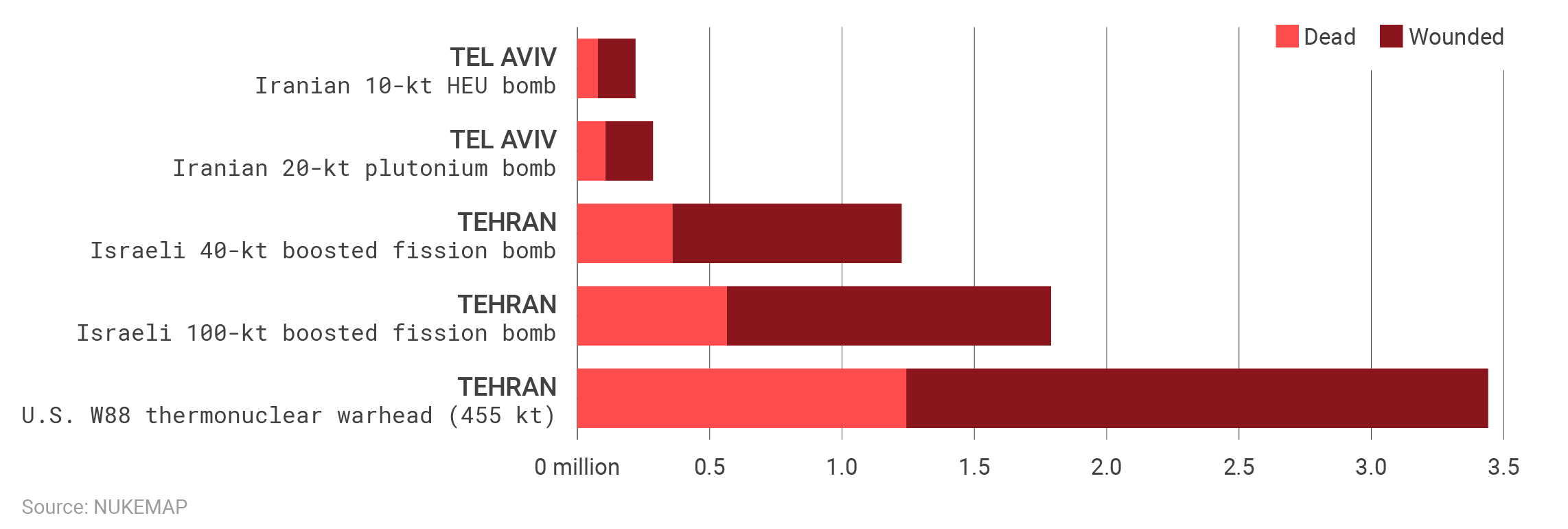
All simulations assume an airburst of 1,650 feet. Iranian yields based on historic output of basic HEU and plutonium designs. Israeli yields are speculative, representing a range of potential outputs with boosted fission devices. The U.S. W88 is carried by the submarine-launched Trident D5 missile.
While it is easy to resort to crude caricatures of “mad ayatollahs,” in truth, Iran has traditionally been circumspect in avoiding actions that leave it open to direct retaliation, often working through proxies and other third parties to achieve objectives. Rarely does it risk clear attribution, as in the case of the Soleimani retaliation. More than likely, Iranian nuclear employment would be most credible when it was facing an existential threat, and the alternatives to nuclear use were equally unpalatable. This presents Iranian nuclear weapons as options of last resort, rather than as viable coercive tools.
How much would nuclear weapons enhance Iranian influence?
The narrow functionality of an Iranian deterrent affects whether nuclear weapons would enhance Iranian regional prestige and influence. Traditionally, status has been seen as a prime benefit of entry into the nuclear club. Notably, this was the original driving motivation for China under Mao Zedong to acquire nuclear weapons.66Lewis, Paper Tigers, 14. But do nuclear weapons still have the same cache in a world with an increasing number of nuclear states and in which there are clear tiers of nuclear powers, some with far more capable arsenals than others?
If Iran could spontaneously produce 25 boosted fission weapons with yields of 50 kilotons, deliverable by road-mobile solid-fueled missiles capable of striking Tel Aviv, the utility of its nuclear forces looks very different. But since Iran cannot do so, its capabilities must be evaluated as they would actually emerge. Given the small nuclear force it would yield, it is not clear nuclear weapons would enhance Iran’s regional standing—unless it significantly expanded the capabilities of its warheads and delivery systems.
Consider the utility of an Iranian bomb against the non-nuclear GCC states. What is Iran’s leverage unless it can credibly threaten to employ one of a handful of nuclear weapons over potentially mundane geopolitical disputes? For example, if the UAE fails to recognize Iran’s ownership of the Greater and Lesser Tunb Islands, does Tehran threaten to level Dubai? Few are likely to believe Iran would risk international opprobrium and deplete its small arsenal simply to legitimize a minor territorial claim.
In fact, Iran already has significant means of issuing believable threats against regional states via its network of non-state proxies and due to its conventionally armed missile force. Either of these are more “useful” than nuclear weapons in implementing policy precisely because they are correctly perceived as something Iran might actually employ.
Calculations can change if it is a matter of extreme importance—for example, U.S. access to Gulf bases for conventional strikes on Iran. In such a context, the Iranian threat carries greater weight because the stakes are far higher. But here threats of Iranian use are undercut by the prospect of retaliation, particularly if U.S. troops would be killed in a potential Iranian nuclear strike. Even more so than with Israel, Iran would be at an extreme disadvantage in a nuclear exchange with the United States, which possesses the means to level every major city in Iran several times over.
Thus, a threat of nuclear use would also be questionable in such a scenario, unless the conventional strikes on Iran were of such intensity they posed a legitimate threat to the regime’s survival—i.e., it had no alternative to nuclear use because it was facing existential defeat anyway. But this, again, casts an Iranian deterrent not as an active tool of coercive statecraft, but rather as a last-ditch measure in the face of cataclysmic defeat.
Today, Iran is largely inoculated against physical invasion, the scenario where it most likely would resort to nuclear use. The U.S. ouster of Saddam Hussein in 2003 removed one of the main threats of territorial aggression against Iran. And the experience of the ensuing eighteen years created conditions where it is next-to-impossible to imagine Iraq allowing its territory to be used by the United States for a land attack on Iran, one that might require the reintroduction of perhaps 100,000 or more U.S. ground troops.
Similarly, the growing gap between Washington and Ankara argues strongly against Turkey being used to support a land attack into Iran.67For a good discussion of Turkey’s increasingly independent foreign policy under Recep Tayyip Erdogan, see Asli Aydintasbas, “Turkey Will Not Return to the Western Fold,” Foreign Affairs, May 19, 2021. https://www.foreignaffairs.com/articles/turkey/2021-05-19/turkey-will-not-return-western-fold.
Without either Iraqi or Turkish territory, viable scenarios for ground invasion of Iran become extremely difficult to conceptualize.68Mike Sweeney, “Amid Heightened Tensions with Iran, a Thorny Question: Would Regional Partners Accept a Massive Influx of U.S. Troops?” Modern War Institute, January 3, 2020, https://mwi.usma.edu/amid-heightened-tensions-iran-thorny-question-regional-partners-accept-massive-influx-us-troops/. The one instance where Iran would most need its nuclear weapons appears to be among the least likely to occur.
Would other states go nuclear in response to Iran?
Saudi officials have been unabashed in asserting the kingdom would seek its own nuclear capability if Iran crosses the threshold.69For example, in a 2018 interview with Norah O’Donnell for 60 Minutes, Saudi Crown Prince Mohammed bin Salman stated that Saudi Arabia would “follow suit as soon as possible” if Iran develops a nuclear bomb. “Saudi Arabia’s Heir to the Throne Talks to 60 Minutes,” CBS News, March 19, 2018, https://www.cbsnews.com/news/saudi-crown-prince-talks-to-60-minutes/. This has stoked longstanding fears of a so-called “cascade of proliferation” in which additional states opt to pursue a bomb in response to a single act of nuclear proliferation.70There has been a longstanding fear of “dominos falling” in the Middle East if a state beyond Israel sought nuclear weapons. A 2004 UN Report crystalized those fears when it listed a “cascade of proliferation”—not just in the Middle East, but globally—as one of seven principal threats to global security. See A More Secure World: Our Shared Responsibility, Report of the Secretary-General’s High-level Panel on Threats, Challenges, and Change, (New York: United Nations, 2004): 40, https://www.un.org/ar/peacebuilding/pdf/historical/hlp_more_secure_world.pdf. Turkey and Egypt are frequently cited as candidates to follow this path, with Algeria being another country of concern should Iran and then Saudi Arabia field nuclear weapons.71Henry Sokolski, “In the Middle East, Soon Everyone Will Want the Bomb,” Foreign Policy, May 21, 2018, https://foreignpolicy.com/2018/05/21/in-the-middle-east-soon-everyone-will-want-the-bomb/.
None of these states is positioned to quickly make the leap to a nuclear weapons capability.72For a good overview of each country’s historical interest in nuclear technology, see Nuclear Programmes in the Middle East: In the Shadow of Iran (London: International Institute for Strategic Studies, 2008): 17–34, 40–47, 61–71, 107–113. Excepting Algeria, they do not even possess operational reactors at this point.73Egypt and Turkey are constructing light water nuclear plants with Russian assistance at El Dabaa and Akkuyu, respectively. Saudi Arabia was reported to be nearing completion of a research reactor in 2019, but its current status is unclear. Algeria has operated two reactors for thirty years, including the Es Salam heavy water facility. See “Hydraulic Testing Completed on Akkuyu-1 Reactor Vessel,” Nuclear Newswire, July 22, 2020, https://www.ans.org/news/article-367/hydraulic-testing-completed-on-akkuyu1-reactor-vessel/; “Construction Permit Application for Egyptian Reactors Submitted,” Nuclear Newswire, July 6, 2021, https://www.ans.org/news/article-3045/construction-permit-application-for-egyptian-reactors-submitted/; Julian Borger, “Saudi Arabia’s First Nuclear Reactor Nearly Finished, Sparking Fears over Safeguards,” Guardian, April 4, 2019, https://www.theguardian.com/world/2019/apr/04/saudi-arabias-first-nuclear-reactor-nearly-finished-sparking-fears-over-safeguards; and Nuclear Programmes in the Middle East, 107–108. Most would also need to develop effective delivery means as none currently operates stealthy aircraft or missiles with sufficient range and capability to deliver a nuclear warhead throughout the Middle East.
Saudi Arabia might be an exception if reports are true it purchased DF-21 medium-range missiles from China in 2007.74Neither Beijing nor Riyadh has ever publicly confirmed the transfer of the DF-21s. Although it reportedly took place in 2007, it did not become public knowledge until Newsweek broke the story in 2014. See Jeff Stein, “Exclusive: CIA Helped Saudis in Secret Chinese Missile Deal,” Newsweek, January 29, 2014, https://www.newsweek.com/exclusive-cia-helped-saudis-chinese-missile-deal-227283. The DF-21 would give Riyadh a powerful, solid-state missile designed by China to carry both conventional and nuclear warheads.75Although the CIA was reportedly allowed to inspect the original transfer of DF-21s to ensure that it was a conventional variant, the Saudis have subsequently dropped public hints that they might also have a nuclear capable version. See the discussion in Jeffrey Lewis, “Why Did Saudi Arabia Buy Chinese Missiles?” Foreign Policy, January 30, 2014, https://foreignpolicy.com/2014/01/30/why-did-saudi-arabia-buy-chinese-missiles/. For more on the DF-21 missile itself, see “DF-21 (Dong Feng-21 / CSS-5),” Missile Threats, Center for Strategic and International Studies, Updated January 2, 2020, https://missilethreat.csis.org/missile/df-21/. Riyadh also appears to be exploring domestic means to produce ballistic missiles.76In 2019, a team led by Jeffrey Lewis of the Middlebury Institute of International Studies uncovered satellite evidence that Saudi Arabia had constructed a facility for missile production adjoining a missile base al-Watah. See Paul Sonne, “Can Saudi Arabia Produce Ballistic Missiles? Satellite Imagery Raises Suspicions,” Washington Post, January 23, 2019, https://www.washingtonpost.com/world/national-security/can-saudi-arabia-produce-ballistic-missiles-satellite-imagery-raises-suspicions/2019/01/23/49e46d8c-1852-11e9-a804-c35766b9f234_story.html.
In general, though, Saudi Arabia’s nuclear prospects are overstated—at least in the short term. Specifically, the possibility of Pakistan transferring complete nuclear devices to Saudi Arabia in exchange for past financial support is likely exaggerated.77Colin H. Kahl, Melissa G. Dalton and Matthew Irvine, Atomic Kingdom: If Iran Builds the Bomb, Will Saudi Arabia Be Next? Center for New American Security, February 2013, 23–27, https://www.cnas.org/publications/reports/atomic-kingdom-if-iran-builds-the-bomb-will-saudi-arabia-be-next. More useful to Riyadh could be its cooperation with China to identify uranium ore deposits and to set up a processing facility for converting ore into yellowcake, a precursor to HEU.78Warren P. Strobel, Michael R. Gordon, and Felicia Schwartz, “Saudi Arabia, With China’s Help, Expands Its Nuclear Program,” Wall Street Journal, August 4, 2020, https://www.wsj.com/articles/saudi-arabia-with-chinas-help-expands-its-nuclear-program-11596575671; Emma Graham-Harrison, Stephanie Kirchgaessner, and Julian Borger, “Revealed: Saudi Arabia May Have Enough Uranium Ore to Produce Nuclear Fuel,” Guardian, September 17, 2020, https://www.theguardian.com/world/2020/sep/17/revealed-saudi-arabia-may-have-enough-uranium-ore-to-produce-nuclear-fuel. However, even these steps are still a long way from a threshold nuclear capability.79For a detailed discussions of the technological hurdles Saudi Arabia would need to surmount before approaching the nuclear threshold, see Ali Ahmad, “Saudi Arabia’s Nuclear Program: Separating Real Concerns from Threat Inflation,” Bulletin of the Atomic Scientists, October 8, 2020, https://thebulletin.org/2020/10/saudi-arabias-nuclear-program-separating-real-concerns-from-threat-inflation/.
That said, what should concern Iran is the long-term prospect of the Middle East developing into a region of multiple nuclear states. Iran might be the early leader in such an arms race (excepting Israel), but would have limited means to stop other determined regional states from pursuing nuclear weapons. This posits Iran having to continually invest in its nuclear capabilities and delivery systems to remain ahead of its neighbors in the decades ahead.
All of which returns to the question of whether there is a true net gain for Iranian security by going nuclear. If Iran is seemingly fortified against physical invasion, does it make sense to add in the extra security guarantee of nuclear capabilities, should those weapons in turn lead to additional nuclear powers in the Middle East?
Conclusion
States do not always act in accordance with the logic of outside observers. It is impossible to ensure the Iranian leadership has absorbed the calculations discussed in this paper and clearly sees the constraints that would bound the utility of a small nuclear arsenal of low-yield bombs. But Tehran’s engagement with the diplomatic process suggests that perhaps the Iranian leadership does understand the limitations its nuclear forces would face.
A contrast can be drawn with a state like North Korea, whose regime likely will never surrender its nuclear weapons because it believes (perhaps correctly) they are what ensures its ultimate survival. But the Islamic regime in Tehran has other paths open to it and has shown itself surprisingly resilient over the past four decades without nuclear weapons. At the same time, acquiring nuclear weapons could invite existential threats that otherwise might not exist in Iran’s case.
None of this is to suggest Iran be blindly trusted. Compliance with a renewed JCPOA would need to be carefully monitored, with no more important aspect than the status of Arak and its ability to produce tritium or weapons-grade plutonium. It simply is to argue there may be reasons beyond economic incentives Iran could choose to forego nuclear weapons. Whether that translates into re-entry into the JCPOA, of course, remains to be seen.
Endnotes
- 1The first proposal proffered by the P5+1 (i.e., China, France, Germany, Russia, the United Kingdom, and the United States) offering incentives for Iran to cease enrichment of highly enriched uranium was in June 2006. See “Timeline of Nuclear Diplomacy with Iran,” Arms Control Association, Reviewed July 2021, https://www.armscontrol.org/factsheets/Timeline-of-Nuclear-Diplomacy-With-Iran.
- 2On Stuxnet, see Kim Fetter, Countdown to Zero Day, (New York: Broadway Books, 2014). On the assassination of Mohsen Fakhrizadeh, see Farnaz Fassihi, David E. Sanger, Eric Schmitt, and Ronen Bergman, “Iran’s Top Nuclear Scientist Killed in Ambush, State Media Say,” New York Times, Updated December 9, 2020, https://www.nytimes.com/2020/11/27/world/middleeast/iran-nuclear-scientist-assassinated-mohsen-fakhrizadeh.html.
- 3“Timeline of Nuclear Diplomacy with Iran.”
- 4Iran Nuclear Capabilities and Intentions, National Intelligence Estimate, November 2007, https://www.dni.gov/files/documents/Newsroom/Reports%20and%20Pubs/20071203_release.pdf.
- 5For a useful, in-depth analysis of the materials stolen by Israeli intelligence, see David Albright with Sarah Burkhard and the Good ISIS Team, Iran’s Perilous Pursuit of Nuclear Weapons (Washington, DC: Institute for Science and International Security, 2021), https://isis-online.org/uploads/isis-reports/documents/Highlights_of_Irans_Perilous_Pursuit_of_Nuclear_Weapons_August_25%2C_2021.pdf. For debate over the extent to which the files constitute “new” information or merely information the IAEA already previously had access to, see Oliver Holmes and Julian Borger, “Nuclear Deal: Netanyahu Accuses Iran of Cheating on Agreement,” Guardian, April 30, 2018, https://www.theguardian.com/world/2018/apr/30/netanyahu-accuses-iran-cheating-nuclear-deal.
- 6Albright et al., Iran’s Perilous Pursuit of Nuclear Weapons, 31–36, 271.
- 7Little Boy’s yield was 12.5 kilotons and fatalities in Hiroshima were estimated at 140,000 through the end of 1945. Richard Rhodes, The Making of the Atomic Bomb: The 25th Anniversary Edition (New York: Simon & Shuster Paperbacks, 2012) Kindle edition, Location 14890 and 15370.
- 8Hans M. Kristensen and Matt Korda, “United States Nuclear Forces, 2021,” Bulletin of the Atomic Scientists, vol. 77, no. 1 (January 26, 2021): 44. https://doi.org/10.1080/00963402.2020.1859865.
- 9These estimates are based on declassified U.S. government figures cited in Global Fissile Material Report 2013 (Princeton: International Panel on Fissile Materials, 2013): 92.
- 10Martin E. Hellman, “The Physics of Nuclear Weapons,” Undated, Accessed July 14, 2021, https://ee.stanford.edu/~hellman/sts152_03/handout02.pdf.
- 11Tehran operates Bushehr under an agreement with Moscow whereby Iran returns spent fuel rods from the reactor to Russia. If Iran violated this agreement, it could attempt to extract plutonium from the spent rods. But one problem with this method is that the purity of plutonium produced in light water reactors (like Bushehr) is less than optimal for weapon use, running high in the isotope Pu-240 and lower in the more desirable Pu-239. While this type of plutonium can technically fuel a bomb, its use might compromise both the reliability and yield of the weapon. In contrast, heavy-water reactors like Arak have been a reliable source of weapons-grade plutonium for multiple established nuclear weapons programs. On the shortcomings of Bushehr as a source of weapons-grade plutonium, see Jack Boureston and Charles D. Ferguson, “Assessing Iran’s Plutonium Reprocessing Capabilities: A Way to Obtaining Nuclear Weapons Material,” Iran Watch, March 1, 2004. https://www.iranwatch.org/library/private-viewpoints/assessing-irans-plutonium-reprocessing-capabilities-way-obtaining-nuclear-weapons-material.
- 12William J. Broad, “Plutonium Is Unsung Concession in Iran Nuclear Deal,” New York Times, September 7, 2015, https://www.nytimes.com/2015/09/08/science/irans-unsung-plutonium-concession-in-nuclear-deal.html.
- 13“Iran Says to Cold Test Redesigned Arak Nuclear Reactor,” Reuters, March 19, 2021, https://www.reuters.com/article/us-iran-nuclear/iran-says-to-cold-test-redesigned-arak-nuclear-reactor-idUSKBN2BB0K0.
- 14Julia Masterson, “Iran Ratchets Up Nuclear Program,” Arms Control Association, March 2021, https://www.armscontrol.org/act/2021-03/news/iran-ratchets-up-nuclear-program.
- 15Masterson, “Iran Ratchets Up Nuclear Program.”
- 16Fat Man’s yield was estimated at 22 kilotons. Rhodes, The Making of the Atomic Bomb, Kindle location 15520.
- 17On India and North Korea’s respective efforts to test a thermonuclear device, see Jeffrey Lewis, “India’s H Bomb Revisited,” Arms Control Wonk, April 27, 2009, https://www.armscontrolwonk.com/archive/202445/indias-h-bomb-revisited/; Jeffrey Lewis, “Welcome to the Thermonuclear Club, North Korea!” Foreign Policy, September 4, 2017, https://foreignpolicy.com/2017/09/04/welcome-to-the-thermonuclear-club-north-korea/.
- 18Hellman, “The Physics of Nuclear Weapons,” 6–9.
- 19Houston T. Hawkins, “History of the Russian Nuclear Weapon Program,” Los Alamos National Laboratory, November 19, 2013, Slide 37, https://fas.org/nuke/guide/russia/lanl-history.pdf.
- 20“Tritium,” U.S. Department of Energy, Accessed July 30, 2021, https://www.energy.gov/sites/prod/files/migrated/nnsa/2017/11/f42/Tritium%20Fact%20Sheet%20Oct%2017%202011.pdf.
- 21“The Nuclear Testing Tally,” Arms Control Association, July 2020, https://www.armscontrol.org/factsheets/nucleartesttally.
- 22Hans M. Kristensen and Robert S. Norris, “Israeli Nuclear Weapons, 2014,” Bulletin of the Atomic Scientists, vol. 70, no. 6 (November 27, 2015): 104, https://doi.org/10.1177/0096340214555409.
- 23See Avner Cohen and William Burr, “Revisiting the 1979 VELA Mystery: A Report on a Critical Oral History Conference,” The Wilson Center, August 31, 2020, https://www.wilsoncenter.org/blog-post/revisiting-1979-vela-mystery-report-critical-oral-history-conference.
- 24Hellman, “The Physics of Nuclear Weapons,” 2–4.
- 25An implosion design relies on precisely timed, simultaneous detonation of conventional explosives to compress a fissile core, thereby creating the nuclear reaction. On the Iranians foregoing the gun design in favor of implosion, see Albright et al., Iran’s Perilous Pursuit of Nuclear Weapons, 51.
- 26“Types of Nuclear Weapons,” Comprehensive Nuclear-Test-Ban Treaty Organization, Accessed July 30, 2020. https://www.ctbto.org/nuclear-testing/types-of-nuclear-weapons/.
- 27International Institute for Strategic Studies, “Chapter Six: Middle East and North Africa,” The Military Balance, published online February 24, 2021, 340, https://doi.org/10.1080/04597222.2021.1868796.
- 28For more detailed discussion of the tactics Iran has employed to keep its U.S.-made aircraft operational, see Daniel Salisbury, “Tomcat and Mouse: Iranian Illicit Procurement of U.S. Legacy Military Technologies, 1979–2016,” Strategic Trade Review, vol. 3, no. 5 (Autumn 2017): 25–46, https://www.belfercenter.org/sites/default/files/files/publication/Salisbury%20-%20Tomcat%20and%20Mouse.pdf.
- 29“Chapter Six: Middle East and North Africa,” The Military Balance, 340.
- 30For a detailed accounting of GCC fighter aircraft and air defenses, see “Chapter Six: Middle East and North Africa,” The Military Balance, 332, 349, 362, 364–365, 372. For more on U.S. deployments in the GCC, see Mike Sweeney, A Plan for U.S. Withdrawal from the Middle East, Defense Priorities, December 2020, 3–5, https://www.defensepriorities.org/explainers/a-plan-for-us-withdrawal-from-the-middle-east.
- 31The situation has been confused by Iran’s initial assertion that it only used Fateh variants, followed by later U.S. assertions that suggested the attack was carried out exclusively with Qiam variants. Outside analysis tends to support the notion of a hybrid attack. See, for example, the technical assessment carried out by Fondation pour la Recherche Stratégique featuring satellite imagery of the attack site: Agnès Levallois, Vincent Tourret, and Stéphane Delory, “Iranian Operations Against el-Asad and Erbil Bases: What Can Be Learned from the Imagery?—Part One,” Fondation pour la Recherche Stratégique and Geospatial for Intelligence, February 12, 2020, https://www.frstrategie.org/sites/default/files/documents/publications/images-strategiques/2020/strategic-imagery-iranian-operations-against%20el-asad-and-erbil-bases-part-1.pdf; Agnès Levallois, Vincent Tourret, and Stéphane Delory, “Iranian Operations Against el-Asad and Erbil Bases: What Can Be Learned from the Imagery?—Part Two,” Fondation pour la Recherche Stratégique and Geospatial for Intelligence, February 12, 2020, https://www.frstrategie.org/sites/default/files/documents/publications/images-strategiques/2020/strategic-imagery-iranian-operations-against%20el-asad-and-erbil-bases-part-2.pdf.
- 32Michael Elleman, “Iran’s Missiles: Evolution and Arsenal,” The Iran Primer, United States Institute of Peace, January 15, 2021, https://iranprimer.usip.org/blog/2021/jan/15/biden-iran-missile-program.
- 33Levallois, Tourret, and Delory, “What Can Be Learned from the Imagery?—Part Two,” 7.
- 34Dan Lamothe, “These U.S. Troops Survived One of the Greatest Crises of the Trump Era. A Year Later, They’re Still Coping,” Washington Post, January 10, 2021, https://www.washingtonpost.com/national-security/us-military-iran-missile-attack/2021/01/10/651c3930-4fb0-11eb-b2e8-3339e73d9da2_story.html.
- 35Sebastien Roblin, “Meet the Qiam Missile Iran Used to Blast a U.S. Airbase,” National Interest, January 11, 2020, https://nationalinterest.org/blog/buzz/meet-qiam-missile-iran-used-blast-us-airbase-112911.
- 36“Shahab-3,” Missile Threats, Center for Strategic and International Studies, Updated July 31, 2021, https://missilethreat.csis.org/missile/shahab-3/.
- 37Liquid-fueled systems generally have longer range and greater payload capacity compared to solid-fueled systems of the same class. Solid-fueled missiles, on the other hand, offer the advantage of being stored ready-to-fire, skipping the lengthy fueling process liquid systems must undergo. They are a more difficult technology to develop, but their solid-state tends to make them more reliable and stable. For a more detailed discussion of the characteristics of ballistic missiles, see John Pike with Steven Aftergood, “Ballistic Missile Basics,” Federation of American Scientists, Updated June 4, 2000, https://fas.org/nuke/intro/missile/basics.htm.
- 38See Open-Source Analysis of Iran’s Missile and UAV Capabilities and Proliferation, International Institute for Strategic Studies, April 2021, 17, https://www.iiss.org/blogs/research-paper/2021/04/iran-missiles-uavs-proliferation. Michael Elleman has suggested it would take a year or two of additional testing for Sejjil to be considered operational. See Elleman, “Iran’s Missiles: Evolution and Arsenal.”
- 39The effort under Amad to mate a nuclear warhead to the Shahab-3 missile was known as Project 111. See Albright et al., Iran’s Perilous Pursuit of Nuclear Weapons, 200–217.
- 40Early in its nuclear weapons program, Chinese weaponeers had sufficient concerns about their warhead’s ability to withstand the extreme temperature changes and intense vibrations associated with ballistic missile flight that they actually test-fired a live weapon atop a ballistic missile to validate the design. See Jeffrey Lewis, Paper Tigers: China’s Nuclear Posture (London: International Institute for Strategic Studies, 2014): 49–50.
- 41For background on Israel’s nuclear program, see Avner Cohen, Israel and the Bomb (New York: Columbia University Press, 1998).
- 42Estimate of Israeli warheads taken from Hans M. Kristensen and Matt Korda, “VIII. Israeli Nuclear Forces,” in “10. World Nuclear Forces,” SIPRI Yearbook 2021: Armaments, Disarmaments, and International Security, (Stockholm: Stockholm International Peace Research Institute, 2021): 391, https://www.sipri.org/sites/default/files/2021-06/yb21_10_wnf_210613.pdf. For more on the debate over Israel’s potential stockpile of fissile material and its implications for the potential size of its arsenal, see Kristensen and Norris, “Israeli Nuclear Weapons, 2014,” 102–103.
- 43Sang Min-Kim, “New Work Underway at Israeli Nuclear Site,” Arms Control Association, April 2021, https://www.armscontrol.org/act/2021-04/news/new-work-underway-israeli-nuclear-site.
- 44Kristensen and Norris, “Israeli Nuclear Weapons, 2014,” 104–105.
- 45Indian yield taken from Hans M. Kristensen and Matt Korda, “Indian Nuclear Forces, 2020,” Bulletin of the Atomic Scientists, vol. 76, no. 4 (July 20, 2020): 218, https://doi.org/10.1080/00963402.2020.1778378.
- 46Ankit Panda, “U.S. Intelligence: North Korea’s Sixth Test Was a 140 Kiloton ‘Advanced Nuclear’ Device,” Diplomat, September 6, 2017, https://thediplomat.com/2017/09/us-intelligence-north-koreas-sixth-test-was-a-140-kiloton-advanced-nuclear-device/; Frank V. Pabian, Joseph S. Bermudez Jr., and Jack Liu, “North Korea’s Punggye-ri Nuclear Test Site: Satellite Imagery Shows Post-Test Effects and New Activity in Alternate Tunnel Portal Areas,” 38 North, The Stimson Center, September 12, 2017, https://www.38north.org/2017/09/punggye091217/.
- 47Kristensen and Norris, “Israeli Nuclear Weapons, 2014,” 105–106.
- 48Nuclear certification for the F-35 is expected by January 2023. U.S. Library of Congress, Congressional Research Service, F-35 Joint Strike Fighter (JSF), RL30563 (2020), 22, https://fas.org/sgp/crs/weapons/RL30563.pdf.
- 49Kristensen and Norris, “Israeli Nuclear Weapons, 2014,” 107.
- 50Kristensen and Korda, “VIII. Israeli Nuclear Forces,” 393–394.
- 51The issue of the precise number of launchers is confused by Israel’s general opacity on nuclear matters and the specific question of whether the Jericho 3 has replaced or merely augmented the Jericho 2. See Kristensen and Norris, “Israeli Nuclear Weapons, 2014,” 107–108, and Kristensen and Korda, “VIII. Israeli Nuclear Forces,” 392–393.
- 52Kristensen and Norris, “Israeli Nuclear Weapons, 2014,” 108–109.
- 53For an overview of the Arrow systems’ characteristics, see “Arrow 2 (Israel),” Missile Threats, Center for Strategic and International Studies, Updated June 15, 2018, https://missilethreat.csis.org/defsys/arrow-2/; “Arrow 3 (Israel),” Missile Threats, Center for Strategic and International Studies, Updated June 15, 2018, https://missilethreat.csis.org/defsys/arrow-3/.
- 54Joseph Trevithick, “Israel Tests Arrow 3 Interceptor’s Long Range Performance In First-Ever Alaskan Launches,” Drive, July 29, 2019, https://www.thedrive.com/the-war-zone/29194/israel-tests-arrow-3-interceptors-long-range-performance-in-first-ever-alaskan-launches.
- 55Yaakov Katz, “IAF Mulls Further ‘Arrow’ Deployment,” Jerusalem Post, February 14, 2007, https://www.jpost.com/israel/iaf-mulls-further-arrow-deployment; Yaakov Lappin, “Israel Stepping Up Production of Arrow 3,” Jerusalem Post, June 5, 2013, https://www.jpost.com/defense/israel-stepping-up-production-of-arrow-3-315470.
- 56Karl Vick and Aaron J. Klein, “How a U.S. Radar Station in the Negev Affects a Potential Israel-Iran Clash,” TIME, May 30, 2012, http://content.time.com/time/world/article/0,8599,2115955,00.html.
- 57Judah Ari Gross, “IDF, U.S. Wrap Up Air Defense Exercise; THAAD Anti-Missile System to Leave Israel,” Times of Israel, April 1, 2019, https://www.timesofisrael.com/idf-us-wrap-up-air-defense-exercise-thaad-anti-missile-system-to-leave-israel/.
- 58Michael Elleman and Michael J. Zagurek, Jr., “THAAD: What It Can and Can’t Do,” 38 North, The Stimson Center, March 10, 2016, 5, https://www.38north.org/wp-content/uploads/pdf/2016-03-10_THAAD-What-It-Can-and-Cant-Do.pdf.
- 59Alex Wellerstein, NUKEMAP 2.7, Restricted Data: The Nuclear Secrecy Blog. https://nuclearsecrecy.com/nukemap/. NUKEMAP essentially computerizes the circular slide rule that was developed during the Cold War to allow for manual calculations of the effects of nuclear weapons. See E. Royce Fletcher, Ray W. Albright, Robert F.D. Perret, Mary E. Franklin, I. Gerald Bowen, and Clayton S. White, Nuclear Bomb Effects Computer, (Including Slide-rule Design and Curve Fits for Weapons Effects), CEX-62.2 (Washington, DC: U.S. Atomic Energy Commission Civil Effects Test Operations, 1963).
- 60NUKEMAP simulation of a strike on Tel Aviv run July 22, 2021. Assumes a 10-kiloton warhead with an airburst at 1,650 feet. https://nuclearsecrecy.com/nukemap/?&kt=10&lat=32.088545&lng=34.78254&hob_opt=2&hob_psi=5&hob_ft=1650&casualties=1&psi=20,5,1&zm=13.
- 61NUKEMAP simulation of a strike on Tel Aviv run July 22, 2021. Assumes a 20-kiloton warhead with an airburst at 1,650 feet. https://nuclearsecrecy.com/nukemap/?&kt=20&lat=32.088545&lng=34.78254&hob_opt=2&hob_psi=5&hob_ft=1650&casualties=1&psi=20,5,1&zm=13.
- 62NUKEMAP simulation of a strike on Tehran run July 22, 2021. Assumes a 40-kiloton warhead with an airburst at 1,650 feet. https://nuclearsecrecy.com/nukemap/?&kt=40&lat=35.696&lng=51.401&hob_opt=2&hob_psi=5&hob_ft=1650&casualties=1&psi=20,5,1&zm=13.
- 63NUKEMAP simulation of a strike on Tehran run July 22, 2021. Assumes a 100-kiloton warhead with an airburst at 1,650 feet. Complete figure for estimated wounded is 1,224,090. https://nuclearsecrecy.com/nukemap/?&kt=100&lat=35.696&lng=51.401&hob_opt=2&hob_psi=5&hob_ft=1650&casualties=1&psi=20,5,1&zm=12.
- 64NUKEMAP simulation of a strike on Tehran run July 22, 2021. Assumes a 455-kiloton warhead with an airburst at 1,650 feet. Complete estimated casualties are 1,243,130 dead and 2,197,900 wounded. https://nuclearsecrecy.com/nukemap/?&kt=455&lat=35.696&lng=51.401&hob_opt=2&hob_psi=5&hob_ft=1650&casualties=1&psi=20,5,1&zm=12.
- 65Technically, the Trident has the capacity to carry eight warheads, but due to limitations imposed by the New START Treaty, it likely deploys with five or fewer. See the explanation in Austin Long, “Discrimination Details Matter: Clarifying an Argument About Low-Yield Nuclear Warheads,” War on the Rocks, February 18, 2018, https://warontherocks.com/2018/02/discrimination-details-matter-clarifying-argument-low-yield-nuclear-warheads/.
- 66Lewis, Paper Tigers, 14.
- 67For a good discussion of Turkey’s increasingly independent foreign policy under Recep Tayyip Erdogan, see Asli Aydintasbas, “Turkey Will Not Return to the Western Fold,” Foreign Affairs, May 19, 2021. https://www.foreignaffairs.com/articles/turkey/2021-05-19/turkey-will-not-return-western-fold.
- 68Mike Sweeney, “Amid Heightened Tensions with Iran, a Thorny Question: Would Regional Partners Accept a Massive Influx of U.S. Troops?” Modern War Institute, January 3, 2020, https://mwi.usma.edu/amid-heightened-tensions-iran-thorny-question-regional-partners-accept-massive-influx-us-troops/.
- 69For example, in a 2018 interview with Norah O’Donnell for 60 Minutes, Saudi Crown Prince Mohammed bin Salman stated that Saudi Arabia would “follow suit as soon as possible” if Iran develops a nuclear bomb. “Saudi Arabia’s Heir to the Throne Talks to 60 Minutes,” CBS News, March 19, 2018, https://www.cbsnews.com/news/saudi-crown-prince-talks-to-60-minutes/.
- 70There has been a longstanding fear of “dominos falling” in the Middle East if a state beyond Israel sought nuclear weapons. A 2004 UN Report crystalized those fears when it listed a “cascade of proliferation”—not just in the Middle East, but globally—as one of seven principal threats to global security. See A More Secure World: Our Shared Responsibility, Report of the Secretary-General’s High-level Panel on Threats, Challenges, and Change, (New York: United Nations, 2004): 40, https://www.un.org/ar/peacebuilding/pdf/historical/hlp_more_secure_world.pdf.
- 71Henry Sokolski, “In the Middle East, Soon Everyone Will Want the Bomb,” Foreign Policy, May 21, 2018, https://foreignpolicy.com/2018/05/21/in-the-middle-east-soon-everyone-will-want-the-bomb/.
- 72For a good overview of each country’s historical interest in nuclear technology, see Nuclear Programmes in the Middle East: In the Shadow of Iran (London: International Institute for Strategic Studies, 2008): 17–34, 40–47, 61–71, 107–113.
- 73Egypt and Turkey are constructing light water nuclear plants with Russian assistance at El Dabaa and Akkuyu, respectively. Saudi Arabia was reported to be nearing completion of a research reactor in 2019, but its current status is unclear. Algeria has operated two reactors for thirty years, including the Es Salam heavy water facility. See “Hydraulic Testing Completed on Akkuyu-1 Reactor Vessel,” Nuclear Newswire, July 22, 2020, https://www.ans.org/news/article-367/hydraulic-testing-completed-on-akkuyu1-reactor-vessel/; “Construction Permit Application for Egyptian Reactors Submitted,” Nuclear Newswire, July 6, 2021, https://www.ans.org/news/article-3045/construction-permit-application-for-egyptian-reactors-submitted/; Julian Borger, “Saudi Arabia’s First Nuclear Reactor Nearly Finished, Sparking Fears over Safeguards,” Guardian, April 4, 2019, https://www.theguardian.com/world/2019/apr/04/saudi-arabias-first-nuclear-reactor-nearly-finished-sparking-fears-over-safeguards; and Nuclear Programmes in the Middle East, 107–108.
- 74Neither Beijing nor Riyadh has ever publicly confirmed the transfer of the DF-21s. Although it reportedly took place in 2007, it did not become public knowledge until Newsweek broke the story in 2014. See Jeff Stein, “Exclusive: CIA Helped Saudis in Secret Chinese Missile Deal,” Newsweek, January 29, 2014, https://www.newsweek.com/exclusive-cia-helped-saudis-chinese-missile-deal-227283.
- 75Although the CIA was reportedly allowed to inspect the original transfer of DF-21s to ensure that it was a conventional variant, the Saudis have subsequently dropped public hints that they might also have a nuclear capable version. See the discussion in Jeffrey Lewis, “Why Did Saudi Arabia Buy Chinese Missiles?” Foreign Policy, January 30, 2014, https://foreignpolicy.com/2014/01/30/why-did-saudi-arabia-buy-chinese-missiles/. For more on the DF-21 missile itself, see “DF-21 (Dong Feng-21 / CSS-5),” Missile Threats, Center for Strategic and International Studies, Updated January 2, 2020, https://missilethreat.csis.org/missile/df-21/.
- 76In 2019, a team led by Jeffrey Lewis of the Middlebury Institute of International Studies uncovered satellite evidence that Saudi Arabia had constructed a facility for missile production adjoining a missile base al-Watah. See Paul Sonne, “Can Saudi Arabia Produce Ballistic Missiles? Satellite Imagery Raises Suspicions,” Washington Post, January 23, 2019, https://www.washingtonpost.com/world/national-security/can-saudi-arabia-produce-ballistic-missiles-satellite-imagery-raises-suspicions/2019/01/23/49e46d8c-1852-11e9-a804-c35766b9f234_story.html.
- 77Colin H. Kahl, Melissa G. Dalton and Matthew Irvine, Atomic Kingdom: If Iran Builds the Bomb, Will Saudi Arabia Be Next? Center for New American Security, February 2013, 23–27, https://www.cnas.org/publications/reports/atomic-kingdom-if-iran-builds-the-bomb-will-saudi-arabia-be-next.
- 78Warren P. Strobel, Michael R. Gordon, and Felicia Schwartz, “Saudi Arabia, With China’s Help, Expands Its Nuclear Program,” Wall Street Journal, August 4, 2020, https://www.wsj.com/articles/saudi-arabia-with-chinas-help-expands-its-nuclear-program-11596575671; Emma Graham-Harrison, Stephanie Kirchgaessner, and Julian Borger, “Revealed: Saudi Arabia May Have Enough Uranium Ore to Produce Nuclear Fuel,” Guardian, September 17, 2020, https://www.theguardian.com/world/2020/sep/17/revealed-saudi-arabia-may-have-enough-uranium-ore-to-produce-nuclear-fuel.
- 79For a detailed discussions of the technological hurdles Saudi Arabia would need to surmount before approaching the nuclear threshold, see Ali Ahmad, “Saudi Arabia’s Nuclear Program: Separating Real Concerns from Threat Inflation,” Bulletin of the Atomic Scientists, October 8, 2020, https://thebulletin.org/2020/10/saudi-arabias-nuclear-program-separating-real-concerns-from-threat-inflation/.
More on Middle East
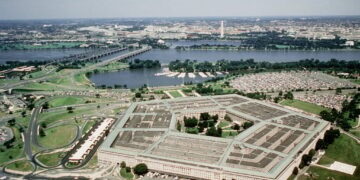
Featuring Jennifer Kavanagh
April 17, 2025

